Batteries are already well known, and in recent years capacitors have become robust enough to start being used either alongside or instead of batteries.
In addition, recent years have seen the emergence of some new ideas which now ready to be included in the range of clean air solutions of tomorrow. These include frequent fast charging of onboard energy storage and power collection from the road surface beneath the bus.
Most people know what batteries are about - after all, who has never used a torch / portable radio / music player / telephone / communications device (etc)? All of these use batteries and it would seem logical that if these
work well then buses should be able to be powered from batteries as well.
Real-world reality is such that so far battery technology has simply not provided the solution that people are hoping for. This is because (especially for large buses) batteries do not carry enough energy to power the bus for a full day.
If this were not so then both diesel and overhead wire trolleybuses would already have been replaced with battery buses.
Another issue with rechargeable batteries is that over time they degrade, which means that the amount of charge they can carry slowly reduces, and the reality is that (at present) none of the known battery
technologies has created a battery with the same longevity as the buses. Some battery technologies are still too new to be sure of exact facts but it is looking likely that all electric buses which use batteries to power the
vehicles will need their battery packs replacing at least once during their commercial lives. When the cost of the batteries is also bourne in mind this can be expensive! Often after a few years use batteries can be reconditioned,
but this process only adds working life to them, it does not return them to full 'as new' condition.
Money is not the only issue. Making / half-life reconditioning / disposing of spent batteries also has environmental consequences. Of course where there is the will to do things properly the environment is easily respected.
All the known and even some unusual battery technologies have been trialled with buses, including lead-acid, nickel cadmium (NiCd) and nickel metal hydride (NiMH). The present-day favourite is lithium-ion (Li-ion), one reason being
because these batteries are considerably lighter. Likely to replace Li-ion technology are batteries made from lithium iron phosphate (LiFePO4) / lithium ferrophosphate (LFP) as these avoid the use of heavy metals and poisonous
chemicals. Whilst they have a lower energy density than the more common Li-ion designs they are expected to offer longer lifetimes, better power density (the rate that energy can be drawn from them) and are inherently safer. This latter
point is important, it means that they are less likely to ignite if mishandled or experience a fault, this being such a significant safety challenge with other designs of lithium battery that complex electronics are required to try and
prevent it from happening. When lithium batteries ignite the resulting fires can be so hot (over 2,000° C) that they can melt concrete.
Note however that the operational, financial and environmental challenges related to battery buses are still easier to resolve than dealing with the human (ill)health consequences of fossil fuel exhaust fumes.
Battery Electric Buses Are Not A New Technology
In 1907 the horse bus reigned supreme. Although horse feed was expensive it was home produced§ and the waste material (horse dung) was a much sought-after saleable product (as fertiliser). Indeed, especially in the early years some
horse bus companies found that the funds raised by selling the dung made the difference between profit and loss.
§ it was estimated that as much as 25% of arable land within the British Isles was used to grow crops to feed the horses. |
|
In July 1907 a small fleet of battery-electric buses entered passenger service in London. Operated by the London Electrobus Company they used lead-acid batteries which weighed 1.5 tonnes and when fully charged stored
enough energy for 40 miles (60km) of travel. To extend the distance the buses could travel in a day the batteries were replaced with a freshly charged battery pack at lunchtime. They were located in a cradle below the vehicle
(ie: underslung) and the process took just three minutes.
When introduced they compared very favourably with the small number (about 230) new-fangled petrol buses being trialled on London's roads, being of a similar size, cost and passenger capacity. However they were significantly more reliable and neither
made horrid noises which frightened horses nor gave off obnoxious waste gas fumes. |
 |
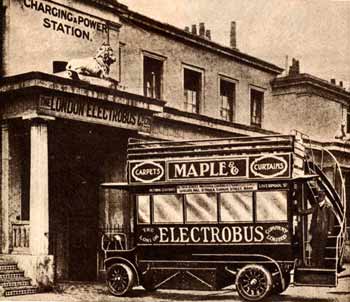
Image: © New Society for the Diffusion of Knowledge (NSDK)
http://www.probertencyclopaedia.com/photolib/transport/Battery%20Bus%20
of%20the%20London%20Electrobus%20Company%201907.htm |
Additional Electrobus Information.
The first Electrobus service linked London's Victoria Station with Liverpool Street station. With the new service proving to be a success it was decided to expand operations to serve more destinations. This required funds to be raised on the stock market.
Initially there was no shortage of investors wanting to invest in the bus company, however that changed once it became known that the mastermind behind it was a fraudster who had a liking for fast cars and champagne. Because of this it proved impossible
to raise sufficient funds via the stock market.
What was not known at the time was that boss (Lehwess) was siphoning off as much as £1 in every £3 that the company raised. To help mask this he created a string of front companies which charged inflated prices to their customers (ie: other
companies within the group). For example, the Electric Vehicle Company (which built the buses) overcharged the London Electrobus Company (which operated the buses) by approximately £300 for each bus. Another scam was that The London Electrobus Company
paid more than £31,000 in advance for 50 buses whilst only 20 were ever delivered. In addition, Lehwess is also said to have used the bank account of the Electric Vehicle Company as his personal piggy-bank!
In 1909 the company went into liquidation. Some historians claim that the collapse was caused by technical drawbacks and a price war, these being comments which would make petrol buses look superior. In reality however it was the rate of financial attrition
which crippled the company. Lehwess even managed to scam the liquidators, convincing them that the eight buses he bought from them for £800 were only fit for spares and then selling them to a bus company in the Brighton, Sussex area for £3,500!
These buses then ran for another six years, which in an era when the life of motor buses was measured in months was quite an achievement and proved the reliability and ruggedness of the Electrobus buses.
By then however something else had happened which rendered these first generation battery buses technically obsolete and despite the hated noise & smells led to the widespread introduction of fossil fuel buses.
Links to more information: 
http://www.economist.com/node/9465026
http://books.google.co.uk/books?id=a5CS6IcW0FEC&pg=PA38&lpg=PA38&dq=%22london+electrobus+company
%22&source=bl&ots=G80yxeApoR&sig=ROkkBAlITZD1kyvqcqBaEblNWVg&hl=en&ei=PCJITMqZNYyTjAfFwuzUDg
&sa=X&oi=book_result&ct=result&resnum=2&ved=0CBkQ6AEwATgK#v=onepage&q=%22london%20electrobus%20company%22&f=false
Why Motorbuses Triumphed Over Battery Buses.
Whilst the bankruptcy of the London Electrobus Company was a tragedy for the advancement of battery power during that era, what really changed everything was the 1910 advent of the B type motor bus.
Being mass produced it was cheaper than its competitors and - crucially - it was very reliable. Within just 18 months London's largest horse bus operator (the London General Omnibus Company - LGOC) had
completely replaced horse traction with these buses. By 1914 London's other bus companies had also stopped using horses.
Motor bus technology continued to advance rapidly and so did the carrying capacity of the buses within the legally mandated laden weight limits. Even if battery buses had of still been used the weight
of the batteries and the requirement for a stronger (thus heavier) vehicle to carry the batteries would have seen a greater proportion of the laden weight allowance having to be allocated to the unladen weight
of the bus than was required for the motorbus with its lighter engine. The resulting reduction in passenger capacity would have seen the battery buses being economically disadvantaged (fewer passengers = less
fares income). This is an issue which 100 years later still applies! (dateline April 2014).
However, the metric changed considerably in the 1930's after the electric buses had started being powered by overhead wires, with many designs of what became known as the trolleybus being physically larger than motor buses and hence being
able to carry more passengers (than motor buses) whilst remaining within the legally mandated overall weight limits.
 |
Commercial Experience That Battery Technology
Is Not Yet Robust Enough For Large Buses
Some present-era examples of the issues regarding battery life can be found from Shanghai in China plus Rome and Pelermo in Italy.
Included in the public transports for the 2010 World Expo which was held in Shanghai was a dedicated fleet of 120 battery electric buses. During the Expo these were mostly used as tourist shuttles, for which their 80km (50miles)
range was sufficient. However they did not perform very well in the scorching summer heat of that year and in order to keep them available to transport Expo visitors the batteries had to be constantly replaced, cooled and recharged.
By 2013 the batteries had degraded to a point where they could only hold enough charge for 60-65 km (37-40 miles) of travel. As the linked news article below suggests, this restricts the services
on which these buses can be used, with frequent recharging between journeys becoming a burdensome necessity.
The bus operator reckons that after 4 - 5 years the batteries will need changing, and with the cost of new battery sets (per bus) being about 1.1 million yuan (US$176,765) so the financial burden represents a significant
deterrent for more widespread use of battery buses. See here:-
http://www.shanghaidaily.com/metro/City-routes-get-120-electric-Expo-buses/shdaily.shtml 
Some reports suggest that rather than replace batteries some Chinese bus operators just scrap the vehicle. It is cheaper and easier.
Experience from Rome comes from a fleet of 30 electric buses which were introduced into service in 2005 and designed for a combination of both trolleybus mode and wire-free battery electric mode. The batteries were capable of powering the buses
for 10km of wire-free travel, although they only actually needed to travel for 3km in this mode plus spend 5-15 minutes laying over between journeys at the city centre bus terminus.
By October 2014 the batteries on all but four of these buses had become life-expired and needed replacing - at a cost of €30,000 each vehicle! Media reports suggest that the batteries
could not cope with the intensive demand placed upon them by the lengthy and busy unwired section in the city centre. As a result most of the fleet had to be taken out of service.
As Rome is extending its trolleybus network it was possible to use some of the new trolleybuses on this 2005 service. What is significant is that for use away from overhead wires the new trolleybuses
have diesel engines, so these have had to be used whilst travelling on the unwired section along inner-city streets and at the bus terminus.
Fortunately in 2016 the original 2005 vehicles were back in service, which implies that life-expired batteries had been replaced on these battery / trolley buses.
Palermo has 13 hybrid buses which date from 2001 and it is no longer able to use - because it cannot afford an estimated €400,000 for new batteries. |
Towing battery trailers behind the bus is an option which has the potential to solve the issues of batteries abstracting from overall passenger capacity and taking up valuable passenger inside the vehicle.
However trailers introduce many new complexities; in short this concept has not found favour - as otherwise many bus systems would be doing it!
Saskatchewan Transportation Company electric bus
and battery trailer at the Bus Service Center, Saskatoon. |
 |
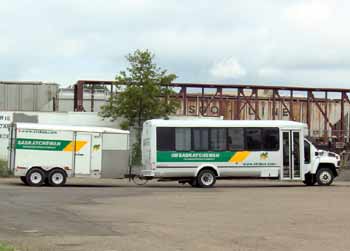
Image & license: SriMesh / Wikipedia encyclopædia. CC BY-SA 3.0
http://commons.wikimedia.org/wiki/File:BusAndTrailerSaskatoonSTC.jpg |
In the 1970's there were British trials with an electric Leyland National bus which towed lead acid batteries in a small trailer. The batteries weighed almost as much as the bus! The aim was to emulate the success of the milk float*
but experience showed that the 40 mile range of the batteries was significantly less than what had been hoped for. Had the experiment proven more successful then although there would have had to be much investment in battery handing and charging
facilities plus the creation of space for all the trailers at bus garages, with Leyland National buses being characterised by having noisy diesel engines which emitted waste gases that included plumes of black smoke so such investment would have
represented money extremely well spent.
*Milk floats were low-speed battery powered local area delivery vehicles used by milk delivery companies which each morning used to be familiar sights in British urban areas.
Emerging Technologies
Scientists are feverishly trying to find new solutions to battery life issues, it is not intended to report on them all but what may yet prove to be a gamechanger for passenger transport is that in June 2013 some German
researchers claimed to have created a lithium-ion battery that retains 85% of its ability even after 10,000 charges. In theory this means that if a battery is charged once daily then 10,000 charges will take over 27 years to achieve,
however since batteries are more likely to be charged several times a day so it could be that they will reach the 85% after just 10 years. This might still be viable, so that the batteries would only need changing once during the
expected lifetime of the bus... as ever we will only know through real-life experience when the right time has been reached. See here:-
http://www.treehugger.com/cars/german-researchers-create-lithium-ion-battery-retains-85-its-capacity-after-10000-charges.html 
However lithium-ion batteries are extremely unstable and need very careful handling - as otherwise they pose a very severe fire risk. Apparently they contain a liquid electrolyte which is at the root of the problem, and scientists are
working on solid state lithium-ion batteries which are much safer - and it seems will also charge more quickly too. See here:-
http://arstechnica.com/science/2016/03/new-lithium-battery-ditches-solvents-reaches-supercapacitor-rates/ 
Then there is graphene, which when mixed with nanoparticles of silicon and metal oxides makes batteries of far greater capacity than those that exist today. For many applications graphene will be used in single-atom layers
which are known as two-dimensional crystals and the unanswered question which boffins are investigating is how many other materials, when used in this way, will have similar or even more useful attributes? Such
as powerful, safe, lightweight, fast-charging, long lasting batteries?
This is not the place to discuss why this is being suggested, but sometimes on alternative news discussion forums it has been suggested that magnetics can be used as part of a clean and safe source of energy. In tandem with
the sort of changes which are expected to be coming on stream when we start using magnetics will be wide ranging changes to our transport solutions, including the possible replacement of rubber tyres (tires as spelt
in the USA) with magnetic levitation. One reason why this would be so beneficial is that (as with diesel engines) the rubber tyres used on road vehicles represent another source of harmful particulate matter air pollution.
Battery Electric Bus Examples
Battery technology first became proven viable (if given financial support based on environmental issues) with smaller sized buses which are used on relatively short routes where the timetable has been arranged so that there is enough
time between journeys for the batteries to benefit from either 'top-up' charging or being replaced with a fresh set of fully charged batteries.
In the early 1990's Oxford, England, trialled a fleet of four electric minibuses. A report on their first 500 days of operation found that compared to similar diesel buses (and after
taking account of extra emissions at the power station) there was:-
 21% less carbon dioxide, 21% less carbon dioxide,
 98% less carbon monoxide, 98% less carbon monoxide,
 42% less acid gases, 42% less acid gases,
 93% less hydrocarbons, and 93% less hydrocarbons, and
 95% less particulates (the fine particles of soot which clog our lungs, causing lung disease). 95% less particulates (the fine particles of soot which clog our lungs, causing lung disease).
Maintenance costs were comparable to diesels, but because of high design and development costs which were spread over just four vehicles they were twice as expensive to purchase. Their lead-acid batteries weighed-in
at 2 ¼ tonnes, making them about 2 tonnes heavier than the regular diesel buses.
Services using these buses in Oxford ended when local government funding was withdrawn. |
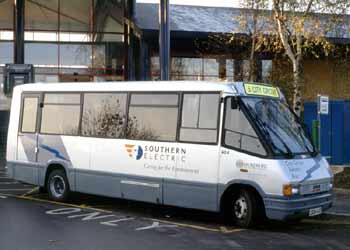 |
 |
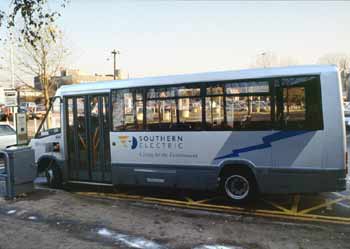 |
Oxford, England. A long wheelbase 'Optare MetroRider' electric minibus 'tops up' its batteries while awaiting its next scheduled journey.
This was done by means of a cable from a roadside
unit plugging in to a socket located on the bus.
 A film showing these buses at this location outside the railway station which includes several scenes
(taken from different angles) of the bus driver physically plugging the power cable into the bus (and unpluging too) can be seen on YouTube at this link: A film showing these buses at this location outside the railway station which includes several scenes
(taken from different angles) of the bus driver physically plugging the power cable into the bus (and unpluging too) can be seen on YouTube at this link:  https://youtu.be/0ywz2_1-CYQ?t=3m40s.
https://youtu.be/0ywz2_1-CYQ?t=3m40s.
As the film also shows other buses this link is set to start at 3 minutes 40 seconds,
which is where the sequence with these buses begins. The focus on these buses then continues all the way to the end of the film.
Despite the environmental advantages, for many years the use of battery electric buses in British towns and cities was minimal. This is most likely because to Britain's cut-throat deregulated bus industry (where finance
is seen to be the only thing which matters) such innovation does not make (financial) sense. For the most part it has required central (or local) government finance for the private bus companies to invest in
electric buses.
Until February 2014 one of the few British conurbations which did use battery electric buses was St Helens, Lancashire. These were operated under the auspices of the Merseyside Passenger Transport Executive (Merseytravel)
who contracted out to private bus companies the operation of several free bus services which used very small battery electric micro-buses. |
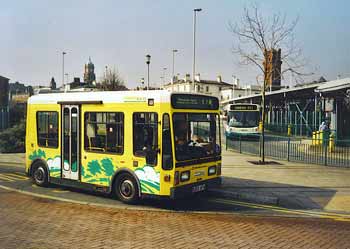 |
 |
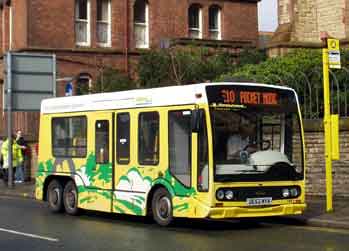 |
One of the six St Helens Tecnobus Gulliver microbuses. Seen at Woodside Ferry Bus Station which connects with the Mersey Ferry.
Image & license: Colin Smith / The Geograph Project. CC BY-SA 2.0
http://www.geograph.org.uk/photo/128704. |
 |
Also used in St Helens are six of these battery electric Tecnobus Pantheon minibuses. Note the twin axle rear wheels.
Image & license: Quackdave / Wikipedia encyclopædia. Public Domain.
http://commons.wikimedia.org/wiki/File:Tecnobus_Pantheon_1.jpg. |
Small fleets of similar battery electric buses are also used in several towns and cities around the globe, where they are often seen to provide a very effective transport solution in pedestrianised and so called
environmentally sensitive areas.
(Ahem, but surely our entire 'living space' aka: the whole planet should be regarded
as being 'environmentally sensitive' - not just a few high-profile streets in a city centre?) |
 |
 |
 |
 |
 |
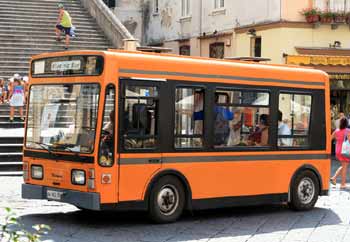 |
| Bordeaux, France, running on a city centre service through narrow streets which despite its small size it still only just manages to negotiate. |
 |
Amalfi, Italy. These Tecnobus Gulliver buses can carry up to 20 passengers, 10 of which are seated.
Image & license: Jensens / Wikipedia encyclopædia. Public Domain.
http://commons.wikimedia.org/wiki/File:Amalfi_bus.jpg. |
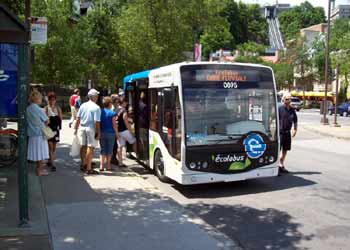 |
 |
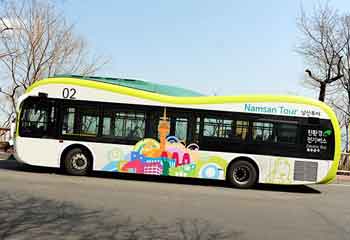 |
Seen at the City Ferry terminal passengers board one of the 8 Tecnobus Gulliver electric microbuses which between 2008 and 2015 were operated by the Réseau de transport de la Capitale in the Old City district in Québec, Canada.
Image & license: zerojay (Jason Carter) / Flickr. CC BY 2.0
http://http://www.flickr.com/photos/zerojay/2727519625/. |
 |
One of the Seoul Metropolitan Government (SMG) battery electric buses which are used on the Mt. Namsan circular routes, as detailed below.
Image & license: Wikipedia encyclopædia. CC BY-SA 3.0
http://commons.wikimedia.org/wiki/File:
Namsan_electric_bus_in_Seoul,_South_Korea.JPG |
In Seoul (Korea) the Metropolitan Government (SMG) in conjunction with Hyundai Heavy Industries and Hankuk Fiber have overseen the creation and introduction of some distinctively styled battery electric buses which are used on leisure-themed
services that serve Mount Namsan. Incredibly this service is promoted as being the first commercial all-electric bus service not just in Korea but anywhere on the planet!
These buses are 11.05 metres in length (about 12 yards / 36¼ ft), have a maximum speed of 100 km/hr (about 62 mph) and are said to be able to travel as far as 83km (about 52 miles) on a single charge.
Using high-speed battery chargers their high-capacity lithium-ion batteries can be fully charged in less than 30 minutes. The route terminus on the mountain has been equipped with four battery chargers. The press release references collecting "energy
generated from brakes when running downhill" which means that they also feature regenerative braking. Whilst this can be very beneficial when travelling downhill the inclines will drain the stored power even more quickly.
To reduce their weight and help maximise the distance they can travel between charges these buses make extensive use of carbon composite materials, instead of metal. They are also of a low floor design and are equipped with automatic
slant boards for wheelchair users. To enhance their visual appeal and create an aura of being different they are shaped like a peanut and decorated with attractive designs symbolizing the Namsan Tower and landscapes of Mt. Namsan.
The first five were introduced in December 2010 as part of a phased replacement of all 14 diesel buses on this service with the new electric buses. The phased introduction was to ensure that if there were any teething issues then it would be possible to
minimise the inconvenience which may be caused to passengers.
Additional information plus some photographs, one of which shows the physical cable 'plug-in' opportunity charging at the Mount Namsan route terminus: 
http://kojects.com/2013/02/08/namsan-e-bus-first-commercial-electric-bus-worldwide/
Also from Asia, the Chinese BYD eBus battery buses which use Lithium Iron-Phosphate batteries have attracted attention of many transport operators planetwide. This is because BYD promote these buses as being able to travel 250km (155miles)
on one charge, in heavy city traffic, with the air-conditioning switched on. Trials in Poland in 2013 suggest that even further may be possible, albeit not the 350km (217miles) which the public transport operator in Warsaw, the Polish
capital city, has said that it needs from a battery bus to provide a full day's use from the one overnight charge. It is important to remember that these are new buses with new batteries - there is a need to see them in daily use for at least 5 years
to know the likely longevity of their battery packs. By the time we reach 2018 there will be no shortage of real-world data, as many thousands of these buses using these batteries are being introduced to various Chinese cities as well as 700 to the Dan
bus company in Israel and small experimental fleets to many bus operators in about a dozen nations around the planet. This includes London and Nottingham.
Batteries: How Often To Charge? Once A Day Or Frequently Daily?
There are several different ways of using battery buses emerging. The issue is that batteries offer a significantly lower energy density than a tank of liquid fuel, and whilst in theory it should be possible to compensate for this by carrying batteries,
these weigh so much and take up so much physical space that if the bus is to remain within legally mandated axle weight limits it risks ending up with a lower passenger capaciy. On the other hand, fewer batteries might mean that the bus can carry more people
but the distance it can travel before the batteries need recharging will be reduced.
The philosphy of Chinese bus builder BYD is that buses should only have their batteries charged overnight, when electricity is cheaper. They do not favour additional top-up charges during the day. To make this possible their buses carry a heavy load of batteries.
Especially for shorter distance city centre circular type services the total distance travelled during the day is so low that the BYD solution will work well.
Many other bus builders companies and some bus operators prefer to not devote so much space and weight to batteries and see a solution to top-up charging the bus batteries during the day, as then their buses will be able to carry more passengers - and possibly even
travel a longer distance during the working day. They also see how solar power can be harnassed to provide the power required for the frequent top-ups. beneft Fewer batteries also reduce headline bus purchase costs - and battery replacement costs.
Opportunity charging advocates also point to higher (greater) use of charging infrastructure during the day as helping justify the cost of installing it, whilst fewer batteries on the buses equate to 17% more passenger being carried,
High utilization of charging infrastructure and the limited battery weight in the opportunity charging concept makes it superior in cost efficiency towards overnight charging.
– The opportunity charging concept allows 17% more passengers.
– Overnight charged battery buses are convenient for testing the new technology in small scale, but have strong limitations in the daily range. This restricts it to slow routes, therefore with limited benefits.
-The opportunity charged buses can adapt to long workdays, high passenger capacity and high mileage. Thereby they deliver strong benefits for the city.
Batteries: How Often To Charge? Once A Day Or Frequently Daily?
Between December 2013 and August 2016 London trialed two of these 12 metre BYD K9 battery electric eBuses on the Red Arrow bus services (routes 507 and 521) which operate Monday - Fridays only. The evaluations suggested that these buses would be viable
on these services and placed an order for 51 eBuses from BYD, although only the chassis plus drivetrain and batteries, as it was decided to use British-built bodywork. The newer eBuses are seen further down this page.
Just before the first of the new eBus fleet started to arrive these two K9 buses were returned to BYD. It is understood that after refurbishment and upgrade to the latest specification BYD will use them as demonstrators. |
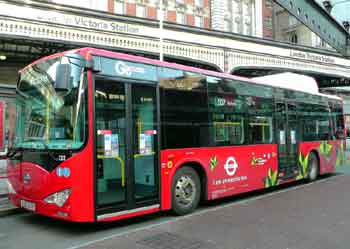 |
 |
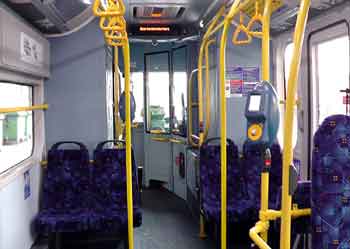 |
One of the two BYD K9 eBuses which London evaluated between 2013 and 2016. Their batteries are stored in a pod on the roof at the back of the bus plus inside the bus in two floor - to - ceiling compartments which are
located behind the driver on both sides of the bus. The 3,000kg weight of the batteries reduces the overall passenger capacity from 96 (on the diesel Citaro buses which are also used on the Red Arrow bus services) to just 69 passengers. This reduction
is to keep the vehicle's laden weight within the 18,000kg legal weight limit for twin axle buses.
The eBus seen in these images is working on route No.507, which is a short (2½ mile / 4km) city centre service where the end-to-end journey time is only about 15 minutes. Buses on this route tend to make one return journey
per hour, so even if used intensively they are unlikely to travel as much as 100 miles (160km) in the one day. This is significantly less than many buses travel on other services. These buses were also used on route 521, which although longer
is still a relatively short inner-city service.
As an aside, whilst in Poland a BYD eBus set a new global distance record for a battery buses using public roads by travelling 310km (192miles) from Warsaw to Krakow on one charge. What is more, its batteries only consumed
69% of their total available charge, so theoretically in optimal conditions the remaining 31% of charge could have seen it travel about 430km (265miles). However, this was achieved at night, when the roads were empty,
at an average speed of about 50km/h (30mph) and the batteries were still brand new.
  A video showing London's BYD K9 eBuses in action has been placed on the 'youtube' film / video website and can be watched by clicking either the projector icon or the link below.
A video showing London's BYD K9 eBuses in action has been placed on the 'youtube' film / video website and can be watched by clicking either the projector icon or the link below.
http://www.youtube.com/watch?v=XEKJSMqhYKk
|
Also in London and originally operating on the two Red Arrow bus routes are two 12 metre Spanish Irizar i2e battery electric buses.
These buses use a combination of sodium-nickel batteries (for energy storage) and ultra-capacitors (for regenerative braking).
Capacitors are better than batteries (of any type) for this task as they can accept much higher rates of energy than batteries (ie: can absorb more energy more quickly). However they have much lower energy density (ie: can hold significantly less energy)
which explains why few buses use them as the primary mode of energy storage. |
 |
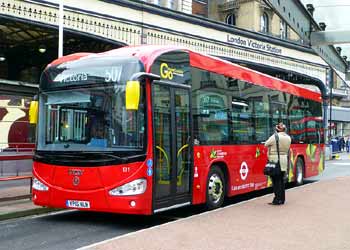
Irizar i2e battery and ultra-capacitor electric
bus on route 507 at Victoria station. |
In 2016 these Irizar eBuses were transferred to bus route 108.
  A video showing London's Irizar eBuses in action has been placed on the 'youtube' film / video website and can be watched by clicking either the projector icon or the link below.
A video showing London's Irizar eBuses in action has been placed on the 'youtube' film / video website and can be watched by clicking either the projector icon or the link below.
http://www.youtube.com/watch?v=xVlhroI6eg4
In May 2016 London started using the first of the planned five 10.2m K8SR double deck BYD battery electric buses on daytime bus route No.98 and night time route No.N98.
It is understood that to help them carry both batteries and a meaningful number of passengers these buses have been given a one tonne derogation on axle weight limits, nevertheless despite this
they still only carry 37 seated passengers upstairs and 17 seated passengers downstairs. |
.
 |
 |
 |
One of London's 10.2m K8SR
double deck BYD battery electric buses. |
 |
The crossed-out section at the back of the lower deck
shows an area that is unavailable to passengers,
presumably because it is where the batteries are stored. |
|
  A video showing some of London's BYD K8SR double deck eBuses in action has been placed on the 'youtube' film / video website and can be watched by clicking either the projector icon or the link below.
A video showing some of London's BYD K8SR double deck eBuses in action has been placed on the 'youtube' film / video website and can be watched by clicking either the projector icon or the link below.
http://www.youtube.com/watch?v=VQM0O9Umu48
|
.
 |
 |
 |
One of London's BYD D9UR chassis / ADL Enviro
200MMC EV body single deck battery electric buses. |
 |
A montage showing (left) my smartphone's power lead
plugged-in to the USB power socket whilst taking this photograph
plus (right) a USB power socket with its blue LED light. |
|
In September 2016 the first of 51 BYD / ADL SEe type eBuses were introduced on London's two Red Arrow bus routes Nos. 507 and 521.
The 12 metre long buses comprise a BYD D9UR chassis with an Iron-Phosphate battery electric drivetrain and a British-built and Alexander Dennis Limited (ADL) Enviro 200MMC EV body.
They feature 21 seats and are permitted to carry a maximum of 72 standing passengers. The seats at at the back of the bus are reached via steps. The priority seats have folding armrests.
The seat backs include USB power sockets, this being the first time that such has been available on Londons' buses. Note however that the sockets are quite small and easily overlooked!
This is London's largest ever fleet of single deck pure electric buses, and the first fleet of battery electric buses to operate in central London since the London Electrobus Company introduced a small fleet of them in 1909.
  A video showing London's BYD / ADL SEe type eBuses in action has been placed on the 'youtube' film / video website and can be watched by clicking either the projector icon or the link below.
A video showing London's BYD / ADL SEe type eBuses in action has been placed on the 'youtube' film / video website and can be watched by clicking either the projector icon or the link below.
http://www.youtube.com/watch?v=uy0EbBKbf7g
|
The second British city to use these buses will be Liverpool, which will be receiving 12 in 2017.
These will operate on city centre circular routes Nos. 26 and 27 which are also known as The Belt.
On this fleet there will be 38 seats plus space for 36 standing passengers. |
 |
 |
Charging The Batteries
Most battery electric buses use 'conductive charging', which is also known as 'direct wired contact' or 'direct coupling'. This well tried and proven system has traditionally involved plugging a cable into a socket on the vehicle.
However other variants exist which involve stationary buses making physical contact with various types of overhead power sources (not trolleybuses / something else) and road surface power supply conductors.
A variant of conductive charging sometimes sees the batteries being removed from the vehicle for recharging. If several sets of batteries are available then immediately replacing them with a fully charged set of batteries
would mean that the bus could be back in service within minutes / without having to wait for the removed batteries to be recharged.
In addition to 'conductive charging' another way to charge the batteries (whilst they still remain in the bus) is via electromagnetic 'inductive charging'. This is further explored under the Roadway Power heading below. |
 |
 |
 |
A battery electric Wrightbus Streetair midi bus demonstrating plug-in charging at a bus and coach industry exhibition in November 2016.
The image on the right is a montage showing the charging post and (above it) the plug-in connection. 
Opportunity Charging
The term opportunity charging refers to daytime 'topping up' the stored energy in the batteries whenever and wherever there is a chance to do so - such as whilst calling at a bus stop - rather solely charging the batteries overnight (in a
bus garage) or swapping out batteries with a freshly charged set during the day. Frequent charging in this way means that the bus can use fewer batteries, as there is no need to even try to make a single charge last for a full day's use.
Fewer batteries equates to a smaller space requirement and less weight, both of which can result in a higher overall passenger capacity.
Both conductive and inductive methods are suitable for opportunity charging, however the bigger question relates to the batteries which (depending in the type of battery) might be damaged - such as experience a
shorter overall life - if charged too quickly.
Note that opportunity charging is only possible at locations where the required physical infrastructure has been installed in advance. What is possible however is that as the technologies described below mature some cities will
install charging facilities at some bus stops on the basis that they are used on an 'as required' basis. As batteries start to degrade this scenario will assist in keeping buses in service and delay the inevitable time when fresh batteries will be required.
The disadvantage of opportunity charging is that it requires a bus to be stationary. This can delay the service, although if carried out at busy bus stops where the dwell time is often longer than usual so quick top-ups of 30 - 120 seconds
duration (or at bus termini during the layover between journeys) the recharging period will probably not even be noticed.
With battery buses which also operate for some of the time as trolleybuses it is possible to recharge the batteries at all times the bus is connected to the overhead wires, whether stationary, in motion, carrying passengers...
This is known variously as SlideIn charging and In Motion Charging.
This solution is being adopted in several cities, including Beijing, China; Rome, Italy; São Paulo, Brazil; Landskrona, Sweden; Esslingen, Germany; Budapest, Hungary; and more.
In Beijing trials since 2008 which used battery buses with the aim of replacing the trolleybuses found that not only was it often difficult to find unobstructed locations for opportunity charging but that the commercially viable life of the
batteries was just too short. In addition there was disquiet over the high cost of installing all the charging equipment. With severe urban air pollution making conversion to diesel buses politically unacceptable so Beijing is now expanding its trolleybus fleet
with vehicles that have lithium-ion batteries (for use on short unwired sections) which are re-charged whilst travelling in trolleybus mode.
In Landskrona the single trolleybus route is being used as a means to electrify other bus services without installing any extra infrastructure. The experimental bus simply switches between the various routes, operating in either battery or grid-connected trolleybus modes
as appropriate. At a later date the bus is to be modified to be compatible with a tram power supplies too. A further phase is also planned but at present the technology does not currently exist - see roadway power below.
Additional information: 
http://ec.europa.eu/environment/life/project/Projects/index.cfm?fuseaction=search.dspPage&n_proj_id=3922#RM
http://www.slidein.se/en/about-the-project/background/
Another advantage of recharging whilst travelling under trolleybus overhead wiring is that this is compatible with busy roads served by multiple bus routes. Whilst opportunity charging works well on single bus routes which do not share termini, life
could become somewhat chaotic if the bus stops are on the public highway, and more expensive (because many charging stations will be required) when serving multiple high-frequency bus routes (eg: buses on each route come every 5-8 minutes). The scenario being envisaged here
is one where three (or more) buses all arrive at the same time and all need to recharge their onboard energy storage...
|
Viennese Electrics
A battery electric midi bus can be found in the Austrian capital of Vienna where in September 2012 the first of 12 Italian EL Alé Rampini battery electric buses which have a
capacity of 30 passengers started being used on two inner city routes. These 7.72m (a little over 25ft) midi buses are powered by lithium iron phosphate batteries which provide a total capacity of 96kW
and provide enough energy for about 120km - 150km (74 - 93 miles) of travel. In addition to powering the vehicle's Siemens three phase synchronous motor, the batteries supply the onboard electronics, including winter
heating and summer air conditioning. At each terminus they receive a top-up rapid charge lasting about 15 minutes. In addition they are given a full slow charge overnight. The transport operator has said that these buses consume
1.3 - 1.6 kWh/km which rises to 2.5 kWh/km during the coldest winter months. The electric heating explains the higher winter energy consumption.
As the images below suggest, daytime charging is achieved by the bus raising its roof-mounted tram-style pantograph to reach a dedicated pair of trolleybus-style twin overhead wires. Because both live and return feeds are required
so the pantograph is split electrically into two sections.
Vienna has a large well established tram system and at some charging points its 600v dc power supply system is used to recharge the batteries. Since many of Vienna's trams use regenerative braking so often it is these buses (and not the trams)
that end up benefiting. The buses also regenerate their own braking energy. |
.
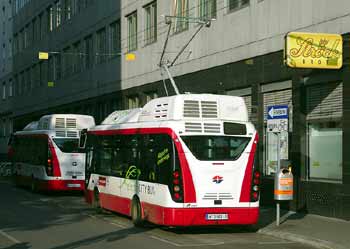 |
 |
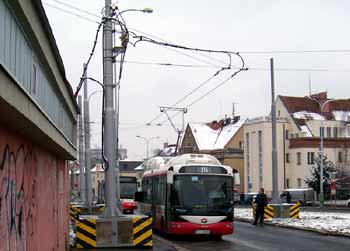 |
Rear view of two route 3A EL Alé Rampini battery electric buses on line 3A during their dwell time at the Schottenring Underground bus stop.
Image & license: darkweasel94 / Wikipedia encyclopædia.
Public domain with correct attribution.
http://commons.wikimedia.org/wiki/File:3A_Zelinkagasse.jpg |
 |
EL Alé Rampini battery electric bus at charging station náměstí Bořislavka whilst on demonstration in Prague, Czech Republic.
This image clearly shows the twin-wire trolleybus style of overhead wiring from
which the pantograph collects electrical energy.
Image & license: ŠJů / Wikipedia encyclopædia. CC-BY-SA-3.0
http://commons.wikimedia.org/wiki/File:
Bo%C5%99islavka,_Siemens-Rampini_(03).jpg |
Important Safety Consideration - Whilst Recharging Via Direct Contact
The system used in Vienna of frequent daytime (fast) top-up charging of batteries is becoming seen as one of the ways that larger buses can overcome the inability of batteries to provide enough power for a full day's use.
It is important that any vehicle which is physically connected to an external source of electricity has robust isolation of its electrics from the body of the bus. Trolleybuses are double isolated and as part of the daily checks that are carried
out before they enter public service (eg: braking system is OK, legally mandated external lights work, tyres are OK, etc) they also have an earth leakage test to ensure that their electrics are safe. Perhaps all buses which
recharge onboard energy storage systems using physical connections to external sources of power whilst in the street domain should also undergo similar daily checks. It would be a terrible incident should the bodywork of a bus that is being
recharged become live and either someone touching the bus or boarding / alighting it ends up being used by the electricity as a pathway to earth. |
One advantage of the system used in Vienna is that if the wires are long enough and power supply system robust enough it could be used by several buses simultaneously. But locating pantographs on bus roofs adds weight, equipment
costs and complexity. In addition, there are extra staff training and maintenance costs.
A different solution which moves all the equipment off the bus uses an inverted pantograph which is lowered to power conductors located on the vehicle's roof. Although only being able to serve one bus at a time this is likely to
become the industry standard.
This is looked at in greater detail at the end of the section about fast charge batteries. |
 |
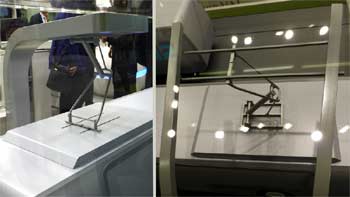
Model vehicles demonstrating two 'above bus'
opportunity charging solutions which use split pantographs,
as seen on a stand at the Milan UITP exhibition in June 2015
left: comes down from above on to the bus roof
right: rises up from bus roof to overhead conductors
- as used by the EL Alé Rampini battery electric buses. |
Fast Charge Batteries
One of the problems with batteries is that they risk being damaged if charged too quickly. Fast charging will also shorten their service life. By way of contrast, bus passengers do not want to be waiting even 10 minutes just so the bus can recharge
its batteries! In an attempt to resolve this an American company has developed a type of battery which it claims is more suited to being fast charged.
Known as Altairnano (nLTO) these batteries use nano lithium titanate, with the titanium being what makes it more able to accept rapid charging and discharging. However, nLTO batteries have a lower inherent voltage than other types of
lithium-ion battery, which leads to a lower energy density and the implication of this is that they are less powerful. As yet it is too soon to be sure of their viable service life,
some estimates suggest six years, others think that it may be much longer. Or shorter. The reason for the uncertainty is that whilst conventional lithium-ion batteries can typically be charged about 1,000 times before they are considered
no longer useful, laboratory tests suggest that nLTO batteries should be able to achieve over 16,000 charge and discharge cycles at rates up to 40 times greater than common batteries, and still retain up to 80% of their initial charge capacity.
This helps explain why trials with real buses are needed to discover real-world results.
By 2013 there were several experiments underway using nLTO battery powered fast charge buses. Included in these trials are some specialist overhead power supply charging systems, albeit with different implementation styles.
In America the first bus which used these batteries was the Proterra EcoRide BE35. This is a 35ft (10.7 metre) 35 seat lightweight carbon fibre / glass fibre composite vehicle. These midi-buses continue to be introduced in an ever
growing number of locations, albeit (so far) only in small numbers. They are fast recharged by stopping with the back of a bus below an overhead power supply unit so that a recharging arm can be lowered to make contact with conductors on the roof of the bus.
Also in the USA, the EBus Trolley is available in a 100% electric version which originally used these fast charge batteries. So far one transport company uses five of these 7 metre, 22 seat replica vintage trolley style buses. This is LINK Transit of rural Wenatchee,
Washington State. Charging is also through the use of an arm which is raised from the back of the bus, and whilst therefore the theme is similar the physical equipment is different to that which the Proterra bus uses.
In 2014 one LINK Transit trolley was switched from nano lithium titanate to lithium-titanate iron-phosphate batteries which have been found to need less frequent charging and provide a longer range. |
This incompatibility between different charging infrastructures may matter, or may not. Certainly for proof of concept trials this is not an issue, however it will aid wider adoption of opportunity charging if all buses
used the same design of open source / vender-neutral charging infrastructure.
More information and photographs can be found at these links: 
http://www.scientificamerican.com/article.cfm?id=battery-powered-electric-bus
http://www.masstransitmag.com/press_release/
12029899/link-transit-launched-five-battery-electric-trolleys
https://www.youtube.com/watch?v=E3IHqJK7_YY
(a short film showing the charging process).
http://www.flickr.com/photos/38680645@N03/7193294832 |
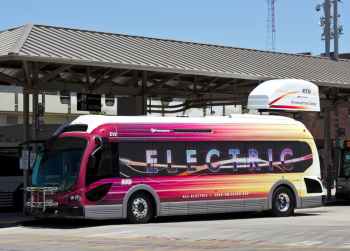
San Joaquin Regional Transit District (RTD) has two of these all-electric Proterra BE35 buses seen here below the "Fast Charging" station.
Image & license: SanJoaquinRTD / Wikipedia encyclopædia.
CC BY-SA 3.0
http://commons.wikimedia.org/wiki/File:
Proterra_Electric_Bus_at_Charging_Station.jpg |
|
In Sweden fast charging trials began with diesel hybrid buses in Umeå (which is in northern Sweden). Although the buses are called Plug-In Hybrids and often include electric plug motifs on their sides they are actually recharged by
raising two small roof-mounted pantographs to reach an overhead power conductor which looks somewhat like a metal bar a couple of metres in length that has been divided into two electrically isolated sections (+ at the front, - at the back). This
is known as a Bůsbaar (the word Busbaar has a small ring ° - as used in some languages - above the letter u) and was created by a Spanish company named Opbrid, in conjunction with some well-known railway industry
component supply companies.
Once the bus has stopped below the Opbrid Bůsbaar the bus driver only has to press a button to initiate the fully automated charging process, during which time s/he can remain in the bus (this is probably very much appreciated in inclement
weather!) The pantographs automatically raise for 5-10 minutes whilst the batteries receive a partial recharge. Full recharges take place overnight.
Trials in Umeå commenced in 2011. An Opbrid Bůsbaar charging station is located at one end of the route and it serves two Hybricon Arctic Whisper fast-charge hybrid buses. These are modified Volvo 7700 series type hybrid buses which are
capable of running with the diesel engine switched off. They have 100 kWh Valence batteries which hold enough charge for up to three hours of fully electric operation, and the aim is that by constantly 'topping-up' the charge the buses will run
in electric mode at all times, albeit with the reassurance that if there are any delays in reaching the Bůsbaar (eg: traffic congestion) then the bus will still have the diesel engine as a fall-back. With near arctic conditions in the winter
and 30° heat in the summer, these trials in Umeå also test the ability of the batteries to withstand a very wide range of climatic conditions. The trials are a collaboration between Hybricon (Sweden), Opbrid (Spain), e-Traction
(Holland), Umeå Energi and Umeå city council. As an aside, electricity in Umeå is sourced renewably.
In April 2014 it was announced that to meet the desire of the bus company to reduce charging times trials are underway with ultrafast charging at 625 amps (400V DC) with the goal being to charge at 500-1000 kW as this would enable charge times of
just 2-3 minutes. Trials in 2014 included two 650 kW charging stations and for 2015 it was planned to build a 950 kW charging station. These buses use batteries specifically designed for high charging rates and cold temperatures. In addition,
the buses with the 100 kWh batteries have been replaced with buses that use different battery types and pack sizes for different charging solutions (as well as a diesel range extender). For 672v charging the buses use 40 kWh battery packs.
Information as per the article, which includes a mix of amp, volt and kWh data. |
More information and photographs can be found at these links: 
http://opbrid.info/umea-reference-site
http://www.greencarcongress.com/2010/10/opbrid-20101006.html
http://www.hybricon.se (Swedish language only)
http://www.opbrid.com/
http://www.prweb.com/releases/2010/10/prweb4603564.htm
http://www.prweb.com/releases/2011/04/prweb5221714.htm
http://www.mobility-magazine.com/fast-charging-electric-with-arctic-whisper/593
http://opbrid.info/umea-reference-site (some excellent photographs)
http://chargedevs.com/newswire/hybricons-arctic-whisper
-electric-bus-demonstrates-ultrafast-charging/ |
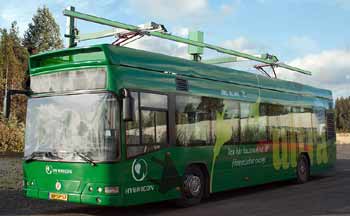
Promotional photograph as supplied with the press release
about the Gothenburg Hyper Bus project. 
Note the two small pantographs which rise
up to engage the elevated power supply rail. http://www.prweb.com/releases/2012/7/prweb9656753.htm |
|
The next location to trial these technologies was Gothenburg, where three Volvo 7900H parallel-type hybrid buses were modified to be able to access an external power source. An Opbrid Bůsbaar was located at each end of the route and the plan was
for the buses to travel as much as possible in battery electric mode. As the buses have 28kWh batteries but only use approximately 8kWh per journey it would have been expected that they would have been able to stay in pure electric mode at all
times, however the route has some steep hills and with the vehicles being the "electric assist" parallel type of hybrid bus where both electric and diesel motors / engines are connected directly to the drivetrain so there are times when the diesel engine
turns on to help the electric motor get the buses up the hills. The buses can also use their diesel engines if they are delayed in traffic and miss some opportunity charging sessions.
The trials in Gothenburg were known as Hyper Bus Project, with the word Hyper being an acronym coming from Hybrid and Plug-in Extended Range Bus system. This project started in September 2011 and ended in 2014. The actual bus service trials
commenced in June 2013. In November 2013 it was announced that the buses in the trial used 81% less diesel fuel per 100km travelled than regular diesel buses.whilst overall energy consumption - including both diesel and electricity - was down by 61% compared to a Euro 5 diesel bus.
More information: 
 (Hyper Bus Project website) (Hyper Bus Project website)
http://www.hyperbus.se/engelskwebbplats/hyperbus/abouthyperbus.4.7f30c2451341eef1dc180002873.html
 (May 2013: Initial results of trials with plug-in hybrid buses) (May 2013: Initial results of trials with plug-in hybrid buses)
http://news.volvogroup.com/2013/02/25/plug-in-hybrid-bus-saves-75-per-cent/
 (November 2013: Field tests prove without doubt the benefits of plug-in hybrid buses) (November 2013: Field tests prove without doubt the benefits of plug-in hybrid buses)
http://news.volvogroup.com/2013/11/13/plug-in-hybrid-buses-reduce-fuel-consumption-by-81/
 (Also see the Opbrid comment with additional information further down this web page) (Also see the Opbrid comment with additional information further down this web page)
http://www.greencarcongress.com/2013/11/20131114-volvo.html
 (Opbrid webpage about 2013 Gothenburg project with Volvo plug-in hybrid buses) (Opbrid webpage about 2013 Gothenburg project with Volvo plug-in hybrid buses)
http://www.opbrid.com/index.php?option=com_content&view=category&layout=blog&id=36&Itemid=59&lang=en

This link leads to a page from this website which explains the differences between the various types of hybrid propulsion systems:
http://citytransport.info/Hybrid.htm |
.
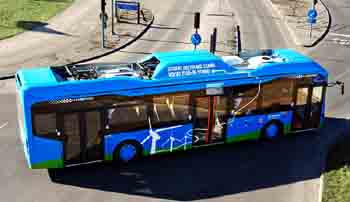
Volvo bus photograph as used on both the ABB
press release about The Vender-Neutral Fast-Charge
Standard and The Hyper Bus Project website.
Click this link to see a closer view of the twin
pantographs (in lowered position) on the bus roof  |
 |
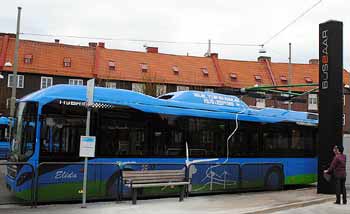
Opbrid promotional photograph showing one
of Gothenburg's Hyper Bus Project buses
at a 300kW Bůsbaar charging station.
pic.twitter.com/zEq07xEJkx |
A Vender-Neutral International Fast-Charge Standard Emerges
In 2014 ABB and Volvo formed a global partnership to create and commercialise a standard charging system for electric and hybrid buses using both an automatic roof-top connection system at bus
stops and overnight cabled charging systems at bus garages.
It seemed sensible that where possible existing open standards-based direct current (DC) protocols would be used, but since none existed for opportunity charging at bus stops the partnership formulated
a standardised automatic e-bus fast charging solution, including the wi-fi communications protocol between the infrastructure charging solution and the bus, the electrical
interface and specifications for the rooftop automatic connection system (ACS).
ABB were already experts in fast charging systems, having delivered such for automotive, utility, government and retail customers including nationwide networks in Denmark, Estonia and Holland.
The idea behind this partnership was that by there being a single international standard to which all urban bus industry and charging infrastructure supply manufacturers could adhere it would facilitate a more rapid expansion of electric
bus networks in our towns and cities whilst avoiding the nuisance of rival and incompatible proprietary systems - such as occurred in the 1980's in the video tape industry.
 Some readers may recall there being several incompatible rival videotape systems. VHS and Betamax were the main variants, but there were others as well.
Some readers may recall there being several incompatible rival videotape systems. VHS and Betamax were the main variants, but there were others as well.
Then there were issues because of different standards for colour television - PAL, NTSC, SECAM - which varied according to nation or region. Unless you owned a rare multi format video player, videotapes recorded in one format would not work on machines designed for a different format, even if the same physical system.
A right mess! For those who have no idea, this link may be of interest:
http://en.wikipedia.org/wiki/Videotape_format_war 
 |
The newly designed ACS uses four conductors - two for power, one for a signal to ensure that all is well and the fourth as an earth - for the bus bodywork. This may sound like belt and braces safety
but it significantly reduces the chance of a freak event resulting in danger. For instance, a very windy day when something is blown on the roof of the bus during the charging process which touches both the bus
body and live conductor at the same time.
What may also be of interest here is that an electric short-circuit protection system was also devised in the 1980's when kerb guided trolleybuses started travelling on kerb guided rights of way which were shared with trams.
The concern was that if the tramway overhead wire should break and fall on to the bus it could make the bus bodywork live, and if this happened at a joint bus / tram station and if someone on the station platform or a boarding / alighting
passenger touched the bus and station platform at the same time then they would be used as part of the electric circuit to earth. To avoid this (and the consequent danger of electric shock, or worse) the buses were fitted with a special
earthing shoe which would automatically lower on to a tram rail as part of the station stop, as this ensured that the body of the bus would be electrically grounded. Trams do not need these special shoes because their steel wheels automatically
create the ground connection, whereas buses use rubber-tyres which electrically insulate them from the ground.
More information: 
http://www.abb.com/cawp/seitp202/6ce621212d3e502ac1257d1c002eb875.aspx
http://articles.sae.org/13457/ (Also includes some data about TOSA [as seen below] charging rates for other buses
and photographs of the Opbrid Bůsbaar.)
http://chargedevs.com/newswire/abb-and-volvo-form-partnership-for-bus-fast-charging/
http://www.prweb.com/releases/2015/05/prweb12729101.htm
(Opbrid announce their support for the new open standards opportunity charging system; this press release dates from after it had been created).
Because of its involvement in this project in September 2014 Luxembourg became the first city to receive some opportunity charged Volvo 7900 Hybrid Concept buses. Eventually it will have 12 such buses, delivery is being phased over time with six scheduled to arrive in 2016.
They are destined to be used on various routes around the city.
More information: 
http://www.wort.lu/en/luxembourg/abb-and-volvo-buses-12-fast-recharging-hybrid-buses-planned-for-luxembourg-53cd28bab9b3988708048882
http://www.sales-lentz.lu/en/information/news/world-premier-volvo-7900-electric-hybrid |
|
In December 2014 Hamburg started using three Volvo Electric Hybrid opportunity charge buses on a new bus service that has been named Innovation Route 109. Over the coming years this 10km route will host buses with many so called innovative
propulsion systems, including fuel cell, pure battery, rigid buses, articulated buses, and (for reference) plain diesel buses. The idea is to create a working laboratory where all the different propulsion systems benefit from identical conditions of use so as to discover
their strengths and weaknesses. This bus route is 9.3km in length, has 23 bus stops and in the rush hours an end - to - end journey can take up to 37 minutes. There are two charging points at each terminus.
More information and photographs can be found at these links: 
http://www.greencarcongress.com/2014/12/20141219-volvo.html
http://chargedevs.com/newswire/volvo-electric-hybrid-bus
-begins-operation-on-hamburgs-innovation-route/
| 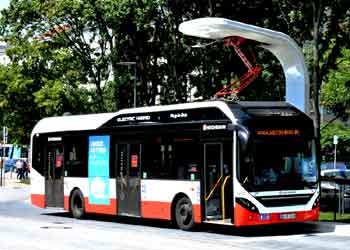
Volvo 7900 Electric Hybrid bus on Innovation Route 109
opportunity charges its batteries.
Image & license: spoorjan / Wikipedia encyclopædia. CC BY-SA 3.0
http://commons.wikimedia.org/wiki/File:HVV_1493-III.JPG |
In January 2015 Volvo and Siemens signed an agreement to market the concept further, including installing it in Hamburg, Stockholm and Gothenburg.
More information: 
http://www.siemens.com/press/en/pressrelease/?press=/en/pressrelease/2015/mobility/pr2015010104moen.htm&content[]=MO
http://www.volvogroup.com/group/global/en-gb/_layouts/CWP.Internet.VolvoCom/NewsItem.aspx?News.ItemId=149238&News.Language=en-gb
In March 2015 trials extended to Stockholm, the Swedish capital city, using eight Volvo 7900 Electric Hybrid buses which have been given human names! This is as part of the ZeEUS project (Zero Emission Urban Bus System) which commenced
in February 2014 and includes the expertise of more than 40 participating companies and organisations, covering innovative electric and extended range hybrid bus solutions in eight cities: Barcelona, Bonn, Glasgow, London, Münster, Plzeň,
Cagliari and Stockholm. The ZeEUS project ends in 2016 by when it is expected that sufficient experience will have been gained for some of the services to continue operating, albeit on a commercial basis.
In Stockholm the opportunity charge buses operate on route No. 73, which passes through the heart of the city centre. There is a charging station at each end of the route, using overhead equipment which was supplied by Siemens. After a quick charge of about
six minutes the fully charged batteries will power the buses in pure electric mode for about 7km after which the bus relies on its biodiesel fossil fuel engine. The demonstration part of the project is scheduled to continue
to the end of 2016, after which the plan is to continue the project on a commercial basis.
More information: 
http://corporate.vattenfall.com/press-and-media/press-releases/2014/electric-hybrid-buses-with-quick-charge-facility-demonstrated-in-stockholm/
http://dailyfusion.net/2014/06/hybrid-electric-buses-stockholm-29748/
http://zeeus.eu/ (ZeEUS project) |
.
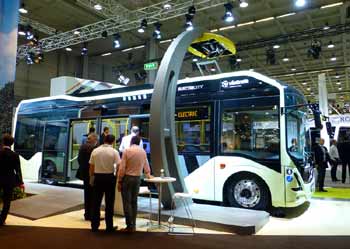 |
 |
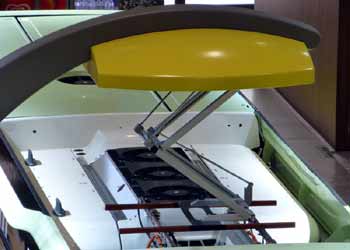 |
One of the pure electric Volvo 7900H Electric Concept buses built for Gothenburg and Siemens ACS at the Milan 2015 UITP exhibition.
As is seen in the image on the right, the H-shaped pantograph head is at right-angles
to the copper contacts which are on the bus roof.
The next stage in Gothenburg occurred in June 2015 when fully electric route 55 was introduced. This is served by 7 Volvo 7900 Electric Hybrid buses and 3 Volvo 7900 pure Electric buses, all of which opportunity charge at both termini. These buses offer passengers free wi-fi internet
and mobile telephone charging facilities. A new innovation is that one of the termini bus stops in indoors - this is only possible because the buses use electric power. The electricity used to charge these buses is sustainably sourced.
More information: 
http://www.goteborgelectricity.se/en/node/19504
http://www.siemens.com/press/en/pressrelease/?press=/en/
pressrelease/2015/mobility/pr2015060258moen.htm&content[]=ICMOL&content[]=MOTPE&content[]=MO
(Siemens press release which includes a photograph inside the bus station showing a bus during the charging process)
http://www.multivu.com/players/English/7544351-volvo-electric-bus-route-launched/
http://busandcoach.com/news/articles/open-standard-charging-stations-for-gothenburg/
http://busandcoach.com/news/articles/indoor-buses-volvo-electricity-shows-the-possibilities/
(A much more indepth article which also talks about the Volvo ElectriCity project in general, the bus stop inside a library(!) and how electric buses could redefine bus travel)
http://www.volvobuses.com/en-gb/news/2016/oct/volvo-abb-inaugurate-charging-station.html
http://www.greencarcongress.com/2016/11/20161109-heliox.html
Commercial Exploitation Starting 2016
Starting in 2016 Volvo pure electric and hybrid buses suitable for opportunity charging via the overhead charging stations became commercially available as part of the Volvo product range.
Volvo market the overhead charging system as OPPCharge
In October 2016 an OPPCharge charging station built by ABB was brought into use outside Volvo’s electric bus terminal in Gothenburg. ABB call their charging stations as Heavy Vehicle Charger (HVC). The text below comes from the press release about this new facility.
It is installed outside Volvo’s electric bus terminal in Arendal, Gothenburg and is a joint reference project between ABB and Volvo Buses. The aim of this cooperative venture is to cooperate on the development and commercialisation of electric buses and electric hybrid buses
equipped with systems for DC opportunity charging using open standards. Demonstrations of buses and charging stations both as products and systems offer a clear picture of what installation at the customer’s premises looks like.
With the new charging station, Volvo is demonstrating that the company’s electric buses are compatible with chargers from several different manufacturers. The buses operating on route 55 are now charged using systems delivered by ABB and Siemens.
It is also noteworthy that Siemens have also demonstrated that their charger is compatible with electric buses built by both Volvo and Solaris.
Another charging station supplier is Heliox. In 2016 one of the public transport operators in Luxembourg (Sales-Lentz,) ordered three Heliox Fast Charge Systems with OppCharge open interface for route terminus opportunity charging in Luxembourg. These will be used with their four Volvo 7900 electric buses.
These charges are expected to start being used in "second quarter 2017".
OPPCharge In The UK
One of the first cities to start using OPPCharge was expected to be Edinburgh, Scotland, where Lothian Buses route No.30 is planned planned to use 24 Volvo 7900 electric buses and two charging stations on. However this has been delayed.
Another new technology which Edinburgh's buses were going to include is geo-fencing. This is an automated AI (artificial intelligence) system which detects and uses the location of the vehicle to change how it operates. The functions it can automatically control include switching the bus into an enforced pure electric mode (to eliminate tailpipe pollution
when passing through air quality management areas) and the ability to restrict the speed at which the bus can travel. This latter feature is promoted as being for use when passing schools, although the information does not state whether at all times (even nights? weekends? other times when the schools are closed?) or only when it is actually beneficial, this being in the
mornings / afternoons when the children are actually travelling to and from school.
In October 2016 it was announced that two other British cities would be using OPPCharge technology ahead of Edinburgh. These are Harrogate and London.
London will be first, using two Wrightbus SRM double deck hybrid buses that will have sufficient battery capacity for up to 7km in pure electric mode before switching to diesel hybrid mode. The SRM buses are a new design which marries a bus body that is based upon the Wrightbus New Bus For London and New Routemaster buses with
a variant of the well established Volvo B5LH double-deck chassis.
(More information about these buses can be found on the A Bus For London page).
As yet the choice of bus route remains unknown, as does when the trials will actually commence. Included in the challenges are the siting of the roadside charging units, especially if they need to be in the street as then they will need planning permission from the relevant local government - this being a process which is rarely quick.
Harrogate will have eight pure electric 7900e buses and three charging stations which will be located in Harrogate bus station. These buses will work on three short Transdev Blazefield bus routes. The system is expected to commence in 2018.
In 2016 the Canadian city of Montreal also started a three year experimental public service using the open-standard OPPCharge system. However the buses to be used will come from the Volvo's North American subsidiary, Nova Bus.
Montreal will use two opportunity charging pylons which will be located at both terminus bus stop on route No.36 - Monk. These will top-up charge the batteries with enough power for 15 km - 25 km of travel. There will also be full slow charges overnight. The trials will include three Nova LFSe electric buses.
This is part of trials by the urban transport operator (Société de transport de Montréal - STM) designed to choose an electric bus technology for its entire network, so that it can switch to only having electrically powered buses.
Additional reading: 
http://lothianbuses.com/news/article/Lothian-Buses-to-order-next-generation-green-buses
http://busandcoach.com/news/articles/2016/electric-volvo-fleet-for-transdev-blazefield-in-harrogate/
http://busandcoach.com/news/articles/2016/world-premiere-for-volvo-b5lhc-electric-hybrid-double-deck/
http://www.stm.info/en/about/major_projects/electrification-surface-system
|
.
 |
 |
 |
Wrightbus bodied with Volvo B5LHC chassis two door SRM double deck hybrid bus under an
OPPCharge overhead pantograph equipped power suuply unit at a bus industry exhibition in November 2016. |
.
 |
 |
 |
The OPPCharge logo as seen on the
lower nearside corner of the windscreen. |
 |
Inside the bus, showing the battery pack just in front of
the centre doors, with a (very high!) luggage area above. |
PIC LOOKING UP TO CHARGER SHOWING H SHAPED CONDUCTORS
Other Fast Charging Projects
There are several other fast charging systems which basically have the same aims but involve other bus manufacturers, bus operators, governmental bodies, etc., Those which are known about are detailed below.
EDDA Bus project
This German system is part of the Fast Charging Systems for Electric Buses in Public Transport joint research project funded by the German Federal Ministry of Education and Research (BMBF). It includes the Fraunhofer Institute for Transportation and Infrastructure Systems IVI
plus several bus / electrical industry companies. Trials with the opportunity charged Solaris Urbino 12 EDDA bus by the Dresdner Verkehrsbetriebe (DVB) began in November 2014 and in June 2015 it entered public service on the 5.2km circular route No. 79 Mickten - Übigau.
Journeys normally take 16 minutes, and since the route operates every 20 minutes this leaves just four-minutes at the terminus for battery charging. This is said to be sufficient for the high-power charger to recharge the batteries and pre-heat the passenger compartment, if
required. The batteries receive a full charge overnight.
Power for charging the bus is taken from the tramway overhead wiring. The charging infrastructure includes a transformer that stabilises output voltage at approximately 748v. The transformer is needed because although the tramway is energised at a nominal 600v this fluctuates
widely - between 500v and 1000v! - with acceleration and regenerative braking of the trams being the cause.
This bus route only needs one bus and when this electric bus is undergoing maintenance it is replaced with a diesel bus.
More information plus some images: 
http://www.fraunhofer.de/en/press/research-news/2015/June/fast-charging-electric-bus-does-overtime.html
http://www.edda-bus.de/en.html
http://www.gizmag.com/fast-charging-edda-electric-bus/37860/
http://www.greencarcongress.com/2015/06/20150601-edda.html (This page has what is probably the best image showing the charging station).
TOSA
TOSA was launched in May 2013 at the UITP exhibition in the Swiss city of Geneva. During the exhibition and for one year afterwards the single Hess Swisstrolley4 articulated electric bus (which has what is described as a small car-sized battery pack) was
used on a short demonstration service which served just a few bus stops between Geneva Airport and Palexpo exhibition centre.
The TOSA system features two different types of charging stations which are located at bus stops along the vehicle's route and at termini. The 400kW en route charging facilities are designed to provide a partial top-up in just 15 seconds,
whilst passengers alight and board. The 200kW termini type charging facilities are deliver a 3 - 4 minute full recharge. To avoid sudden large drains on the urban electricity supply system the fast charging stations use capacitors rated at 3kWh
to store electrical energy that has been slowly drawn from the 50kVA urban power grid. In addition the buses receive a 30 minute 50kVA charge at the bus garage. The onboard energy storage needs recharging every 1km - 1½ km, which works out at about
every second or third bus stop.
The power is transmitted to the bus via a laser-controlled moving arm located on the roof of the bus which connects to an overhead rail that is approximately 1m in length. This current collector is moveable in several directions,
so that the vehicle benefits from a little leeway in its stopping position beneath the power rail. The system is designed for speed, so even as the bus is arriving at the stop the fixed overhead receptacle is being detected
and the rooftop contact arm begins to align itself laterally to it. Once achieved the charging arm rises up from the bus and makes contact. After a safety check has ensured that a proper connection has been made with the stationary bus voltage is applied.
The flash-charging technology and the onboard traction equipment used in this project were developed by ABB and is optimised for high-frequency bus routes in key urban areas, carrying large numbers of passengers at peak times.
The project is a collaboration between TPG; (Transports Publics Genevois - the Genevan public transport operator); OPI - as coordinator for industrial projects; SIG (Geneva power plants) for the power supply; and ABB.
More information: 
http://www.tosa2013.com/
http://www.gizmag.com/tosa-bus-model/32564/
http://www.trolleymotion.ch/index.php?L=3&id=115&n_ID=1796
Note that Geneva already uses both (overhead wire electric) trolleybuses and trams, and concurrent with this trial is introducing a fleet of new trolleybuses which would be expected to still be in use in the 2030's and,
given that trolleybuses often last 30+ years, the 2040's. The tramway has also only just received some new vehicles, one of which is involved in regenerative braking trials using capacitors.
TOSA is not seen as a replacement for trolleybuses, not least because the cost of installing a TOSA system (including the buses, charging stations and electrical supply infrastructure) is expected to be comparable to a new trolleybus
system. Its primary aim is to create a different way to convert diesel / other fossil fuel bus services to electric traction. The systems' reliance on batteries still represents a future liability.
By spring 2014 it was thought that experience of the TOSA system was such that work should start on the next stage, this being the conversion of a 9km diesel bus route which does not serve the city centre (No.23)
to TOSA buses. These plans were confirmed in July 2016.
Although this 9km bus service uses 11 vehicles for the new electric service the route is to modified slightly and there will be 12 electric articulated buses, which will use 13 en-route flash-charging stations plus three terminus four depot feeding
stations. The flash stations will provide 15 second 600-kilowatt boost charges, whilst buses will also receive longer (four / five minute) full recharges at the route termini.
This project is being enacted as part of a strategy for the cleanest possible urban air, which is recognised as only being possible through the elimination of all diesel buses from the built-up area.
Ah, if only similar thinking applied here in Britain too! |
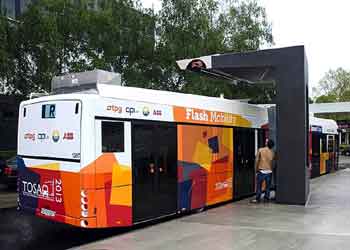
Tosa promotional image of the trial bus at a bus stop charging point. |
 |
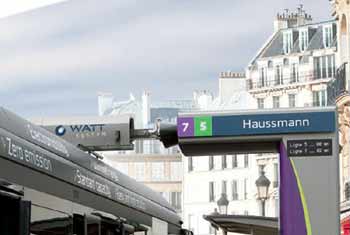
Part of a Watt system promotional image showing the charging arm on the bus plugged in to a roadside bus stop charging point. |
Watt System
The French company PVI (Power Vehicle Innovation) has created a fast charge system which uses supercapacitors to store the energy, with a 10 second 300 watt recharge being expected to provide sufficient energy for 600 - 800
metres of travel. In addition buses are fitted with Lithium-ion battery packs to provide back-up power, if needed, for instance if the bus cannot stop at the correct location to recharge or if it is not carrying passengers and hence
not stopping at bus stops.
Power transfer is whilst calling at bus stops via a collector arm which slides sideways from a housing unit located on the roof of the bus into a socket located either on the roof of a bus stop shelter, as an integral
part of the bus stop flag or as a free-standing totem pole. The recharging stations are also fitted with capacitors.
More information: 
http://www.pvi.fr/watt-r-system,027.html?lang=en
http://www.youtube.com/watch?v=S40VBuln9Qc (a promotional film on youtube)
As part of the system's development and to help gain the all-important initial commercial experience, in October 2014 one bus started non-passenger trials at Nice Côte d'Azur Airport on a service which links the two airport terminals.
The demonstrator will rely on 7 totem poles (or recharge terminals) spread between the different stops along the route.
Winnipeg, Canada
In November 2014 the city of Winnipeg in the Canadian state of Manitoba started using a small fleet of 4 battery electric New Flyer Xcelsior® buses which include opportunity charging as part of their daily operations.
Route No.20 operates 40km round trips linking Winnipeg Richardson International Airport with the city centre and East Kildonan. Whilst passengers alight and board at the airport the bus connects to an overhead charging
facility for an approximate 10 minute top up of its batteries. This delivers enough power for one 2 hour round trip, although the batteries are claimed to store enough energy for 5 hours before a recharge becomes absolutely
necessary. By using opportunity charging in this way the buses can stay in service for more than 20 hours a day, seven days a week.
The project is a continuing collaboration between New Flyer, the Province of Manitoba , Manitoba Hydro, Mitsubishi Heavy Industries, Red River College and Winnipeg Transit. Funding came from Sustainable Development Technology Canada
(on behalf of the Government of Canada) and Manitoba's Vehicle Technology Center. Rather than use pre-existing technology from elsewhere the charging station was developed as part of this project. Almost all electricity
in Manitoba is generated without burning fuel.
More information can be found at this first link and some photographs at the second link: 
http://finance.yahoo.com/news/flyer-battery-electric-buses-enter-180200832.html
http://opbrid.info/winnipeg-reference-site
Plzeň, Czech Republic
In Plzeň (Plsň) two Škoda 12 metre battery buses are used which have different specifications. These are the the ŠKODA 26 BB HP Perun and the ŠKODA 26 BB HE Perun. Both buses are compatible with Euro-American
automotive standard COMBO II (CSS) and can also be charged using quick charger infrastructure designed for plug-in electric / hybrid cars.
The HP (high power) bus been designed for opportunity charging and its lithium-ion batteries have a range of 30km. Rapid recharging at the ŠKODA UFC (Ultra Fast Charger) takes six to eight minutes. The charging method is
via a pantograph which lowers on to copper rail contacts on the roof of the bus. These are protected by a collapsing roof which opens as part of the recharging process once the vehicle is under the charging arm. Slow recharging can
also be carried out at the bus garage.
The HE (high energy) bus is designed for services that do not have the time to stop for fast charging or where there is no possibility to install fast charging infrastructure. It uses high energy density lithium-polymer (Li-Poly)
batteries which have a range of 150km. This bus can still use the Škoda UFC, with a full charge taking 70 minutes. However for a longer battery life overnight 6 - 8 hour charges are seen as being better.
More information, some of which will require online translation: 
http://www.skoda.cz/en/press-room/news/skoda-electric-introduces-its-first-battery-powered-electric-bus/
http://www.greencarcongress.com/2013/11/20131130-skoda.html
http://www.skoda.cz/cs/produkty/elektricke-a-hybridni-autobusy/elektrobus-skoda-hp-perun/
http://www.skoda.cz/cs/produkty/elektricke-a-hybridni-autobusy/elektrobus-skoda-perun-he/
Münster, Germany
April 2015 saw the entire bus route No.14 in the German city of Münster being converted to fast charge electric buses. Here a small fleet of VDL Citeas SLF Electric buses are used on a 12km route which uses opportunity charging at the route termini plus the
bus garage. All five buses are operated (and funded) as part of the ZeEUS project but one of them was also partly funded in connection with the SEB project which is subsidised by the Federal German Ministry of Education and Research (BMBF). The SEB bus has Hoppecke
Lithium-Polymer batteries whilst the other buses have Lithium-Titanate batteries.
The buses use an IFAS (Institute for Fluid Power Drives and Controls) rapid charging system which is on the right-hand side of the bus roof. When stopped at the correct position a robotic arm emerges from the roof of a bus shelter to automatically make contact
with the charging system on the bus. The system can cope with position errors of up to 30cm horizontal and 10cm vertical. A radio link between the bus and the charger sees the batteries telling the charger how much power is required, with up to 500 kW of power
being transferred within 4-6 minutes. IFAS is part of the RWTH Aachen University of Technology, as is the ISEA (Institute for Power Electronics and Electrical Drives) which coordinated both Münster
projects. The batteries only actually need to be recharged after the bus has travelled the route three times, so if for some reason a bus is unable to recharge its batteries when it reaches its terminus (eg: a parked vehicle is in the way) then there should be
sufficient stored energy to skip that charging cycle. At night the batteries are recharged at the bus garage using solar power harvested via photovoltaics (solar panels) located on the workshop and vehicle shed roofs.
The system is completely safe, even during the charging process, so that passengers and the bus driver can board / alight etc., and move around the bus shelter without restriction.
More information: 
http://www.vdlbuscoach.com/News/News-Library/2015/5-VDL-Citea%E2%80%99s-Electric-voor-Stadtwerke-Munster.aspx
http://zeeus.eu/events/launch-event-munster-demonstration
Cologne, Germany
Starting 2016 Cologne (Köln) will be using eight opportunity charged VDL Citea SLFA-180 electric buses on route 33 which is about 7 km long with 13 bus stops and links the Hauptbahnhof (main railway station) with the suburb of Zollstock.
These 18.1m articulated buses will use lithium iron magnesium phosphate (LiFeMgPO4) batteries. Whilst these will be fully charged overnight, during the daytime layovers at both termini they will also receive 5 - 10 minutes of additional opportunity / top-up charging
(at 250 kW). Power will be transmitted using the Schunk power collection system via a retractable pantograph located on the roof (above the middle axle).
As the first of the links explains, the first bus arrived in Cologne on 26th October 2015.
More information: 
http://www.vdlbuscoach.com/News/News-Library/2015/Levering-van-eerste-VDL-Citea-SLFA-180-Electric-aa.aspx
http://www.prestigeelectriccar.com/en/news/1552/World_premiere_the_VDL_Citea_SLFA_Electric
http://coachandbusweek.co/2014/07/vdl-to-build-electric-artics-for-kvb-cologne-trail/ |
.
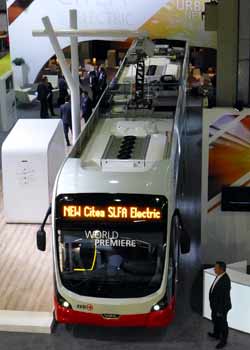
One of the VDL Citea electric buses destined for Cologne
on display at the June 2015 UITP exhibition in Milan, Italy. |
 |
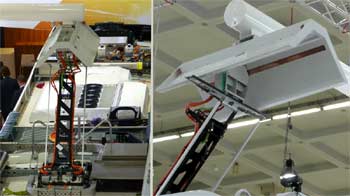
Closer views of the Schunk power collection system which
uses an arm that rises from the roof of the bus, as seen:
left: looking down from an upper floor
right: standing next to the bus and looking up. |
Barcelona, Spain
As part of the ZeEUS Project the Spanish city of Barcelona is supposed (at some stage) to be trialling two opportunity charged articulated buses which are equipped with roof-mounted pantographs. As yet little more is known about this.
This is in addition to the two Irizar i2e battery electric buses which have already arrived, but are not equipped for opportunity charging.
Oberhausen, Germany
As part of a project called Electromobility in Oberhausen two Solaris Urbino 12 Electric buses which use the Schunk power collection system are being used in a study which is about opportunity charging from two different sources of energy.
The reasoning behind this project is that wherever trams and trolleybuses are operated there exists a powerful DC infrastructure which it should be possible to use for bus battery charging.
As part of this feasibility study the local transport operator (Stadtwerke Oberhausen GmbH - STOAG) and the regional transport co-ordinator (Verkehrsverbund Rhein-Ruhr - VRR) installed two fast charge facilities which are directly powered (one each)
from either tramway overhead wiring or a tramway substation.
Abstraction of electricity from the tramway overhead wiring is by means of extra equipment attached to an overhead wire support pole. In addition two outdoor roadside cabinets are required, the first of which contains a circuit breaker for short circuit
protection. This cabinet is also equipped with a surge arrester to secure the system against over voltage events, such as caused by lightning strikes, etc. The other cabinet contains the necessary quick charge control gear. In November 2015 three 50kW quick
charge points were added at this site, these take their energy from the first cabinet. Two of these charging points are for electric cars, the third is for STOAG service vehicles.
It was found that to abstract electricity from the tramway substation it was possible to use the existing sub-station components which produce the DC voltage for the trams, and that the high-power quick charge control gear which regulates the charging
current of the batteries on the buses could be located inside the same sub-station building.
The battery electric buses are used route 962 (15.6 km return journey) and route 966 (13.3 km return journey). Both of these operate 60 minute interval services and only need one bus at a time. At the end of each journey the batteries have a 10 minute recharge.
More information: (all links will require online translation) 
http://www.stoag.de/stoag/elektromobilitaet.html
http://www.stoag.de/stoag/elektromobilitaet/das-projekt.html
https://de.wikipedia.org/wiki/Solaris_Urbino_12_electric#Oberhausen
Hannover, Germany
In 2016 the German city of Hannover will commence trials with three Solaris Urbano battery electric buses which are fitted with 120 kWh lithium titanate batteries. These will be used on ring routes 100/200 which are about 16km in length and have 42
bus stops. The buses are fitted with Schunk pantographs which make contact with a 450 kW charger connection point that is an integral design as part of a bus stop shelter. Located in the city centre at the only terminus for these circular bus routes,
the charging infrastructure was built some years ago to demonstrate the technologies involved during a bus industry exhibition. It draws its power from the tramway power supply system. Normal top-up charges are expected to last about 4-6 minutes,
depending on the season - more power is needed in the winter! Full charges will take about 18 minutes. At night the buses will be slow-charged in the depot using a 32 kW plug-in connection.
More information: 
https://de.wikipedia.org/wiki/Solaris_Urbino_12_electric#Hannover (requires online translation)
https://www.uestra.de/en/about-us/city-bus/elektrobusse/
http://www.busworld.org/articles/detail/2445
Helsinki, Finland and Copenhagen, Denmark
As part of the ePELI Project Helsinki Region Transport (HSL) have bought a small fleet of 12 light-weight aluminium bodied battery electric buses built by a company called Linkker, which is a commercial spin-off of an earlier eBus project. The battery capacity
is 55 kWh. The battery type is Lithium Titanate Oxide. The batteries are fast charged in 1½ - 3 minutes at bus route termini.
The first bus entered passenger service on route No.11 in December 2015, in Espoo, which is a city in its own right within the wider Helsinki Capital Region. Within Helsinki the electric buses will be introduced in 2016 on route No.23 and possibly other bus
routes too. Finland experiences some extreme seasonal weather conditions including very cold, snowy winters and hot summers. These trials will help validate whether the chosen type of battery is capable of offering a viable alternative to fossil fuel on a day
in, day out, basis in this wide range of climatic conditions.
Although bus operations in Helsinki are privatised, for these trails HSL is making an exception to the normal bus procurement process and buying the buses itself, because this way they will retain greater control over events and feel that it would be unreasonable to
expect a traffic company to shoulder the financial risks involved when testing the new technology.
In summer 2016 some fast-charging Linkker battery electric buses will be introduced in Copenhagen, Denmark.
Both Scandinavian projects will use the Schunk/Heliox power collection system.
More information: 
http://www.vttresearch.com/media/news/first-finnish-fast-charging-electric-buses-to-enter-into-service
https://www.walcc.org/index.php/material-bank/project-industry-news/32-project-industry-news-general/216-helsinki-adds-fully-electric-buses-to-public-transit-fleet
http://www.linkkerbus.com/
http://www.linkkerbus.com/naytasivu/NEWS/13
http://heliox.nl/opportunity-charging

Batteries + Capacitors = A Marriage Made In Heaven?
Although batteries are often used to absorb regenerative braking energy only certain types take kindly to doing this, as they prefer slower more regular charging. By way of a contrast, capacitors are excellent for capturing large
amounts of sudden and powerful bursts of electricity such as comes from regenerative braking, but less good at retaining sufficient energy for even medium time periods.
The Chinese saw the potential benefits of combining these two very different electrical storage media in ways which (for quite a few years) the Europeans and Americans failed to do, and in late 2009 introduced in the city of Shanghai a small
experimental fleet of 10 such buses.
Early reports were very encouraging. Using lithium iron phosphate batteries and ultra-capacitors, it is reported that overnight charging of the batteries only requires 3 -5 hours (typically 4 hours, this being half that of other types
of battery bus) and that their range between charging sessions is at least 160km (100 miles) with the air-conditioner switched on, and as far as 250km (155 miles) to 300km (186 miles)
with the air conditioning switched off. A driver on bus route No.825 revealed that on an average day the electric buses (s)he drives typically cover 154km (95 miles) and consumes about 170 kilowatts electricity, which
makes running these buses cost about a third of a diesel engined bus. As an aside, these buses have a moderate maximum speed of 130Km/h (80mph).
In 2014 it was reported that as part of a policy aimed at reducing urban air pollution several hundred of what are known locally as double-electric buses have been introduced in Shanghai. They are largely being used to convert
some of the bus routes which use diesel buses to electric traction. Shanghai also uses trolleybuses and is expanding its fleet of these as well.
Seeking The "Holy Grail" - Viable Alternatives To Batteries
Over the years there have been several attempts to create workable, practical alternative solutions which feature electrically powered buses that can be used for a full day's operation - but without either overhead wires or heavy
batteries. Two solutions which have been trialled, both require frequent recharging but only one seems to be finding favour.
Capacitor Energy Storage / Capabus
Capacitors are solid state electric components that store energy. As technology advances so their properties and the terminologies used to describe them also change, with newer variants being called super-capacitor,
ultra-capacitor, etc. It is beyond the scope of this page to explore the differences between the various types.
Some people add the prefix Capa before the name of a vehicle which uses capacitors. However since the use of capacitor powered vehicles is little known here in Britain so this term has not caught on in general terminology -
and is not used on this page. Another reason for avoiding the capa prefix is because with a slight change of spelling it is possible to make a word which some people find offensive and suggests that something is of extremely
bad quality / not value for money.
The principal constraint in the use of capacitors as alternatives for batteries is clearly understood once their energy density (amount of energy they can store and retain) is compared with batteries. Using weight as a comparator,
an ultra-capacitor can store six (6) watt-hours per kilo, whilst a high-performance lithium-ion battery can store 200 watt-hours per kilo. (Some people say kilogram but when I was at school I was taught that with weight
it is acceptable to drop the word gram).
In June 2005 "early stage" experiments commenced in the Chinese city of Shanghai with electric buses powered via super-capacitors.
Initial testing suggested that when fully charged the capacitors could be able to supply enough power for a bus to travel a total distance of 5km (about 3 miles & 200yds) at 44km/h (a little over 27mph),
although for practicality it was proposed that recharging stations would be located approximately every 3 stops. As the images below suggest, recharging was by means of a scissors pantograph fitted to the buses' roof that
made contact with an overhead power supply. For added benefit these buses featured regenerate braking, so that energy was recycled back into the capacitors - instead of just being lost as friction and heat via the brakes or rheostats.
For the initial testing the Shanghai Sunwin Bus Plant built four prototype super-capacitor electric buses, each one costing as much as 800,000 RMB, this being almost as twice expensive as a conventional Sunwin air-conditioned trolleybus.
However in February 2006 it was reported that with all four test vehicles having broken down the opening of a proposed demonstration system had been postponed indefinitely. |
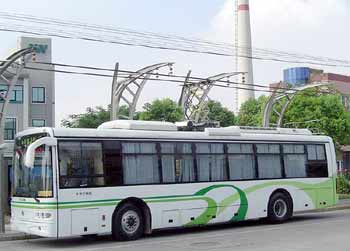 |
 |
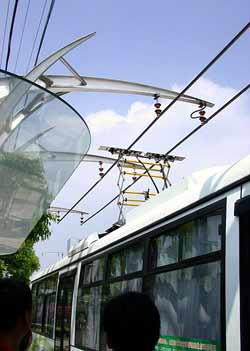 |
Prototype Shanghai capacitor electric bus at a recharging station. Note the use of scissors pantographs for power collection.
Despite it being of the utmost importance that other vehicles do not park
illegally, blocking the recharging facility, this does happen.
Photographs and much information courtesy of Zachary Jiang.
However to properly evaluate the technology a further batch of super-capacitor buses was built, and on 28th August 2006 was placed into experimental service. These more extensive commercial trials involve Shanghai's route 11, which
is a short circular trolleybus route of just 5.5km in length. This route is noted for lower levels of traffic congestion than the others, a constant passenger volume and high flow rate, with most passengers only travelling for three to five
stops. This last point is significant, as it would mean that the passengers would be less likely to experience extended journey times from the frequent recharging.
The trials involve the capacitor buses travelling on the clockwise loop only, with conventional trolleybuses remaining on the counter-clockwise service. Furthermore, the trolleybus overhead for the clockwise circle is still being properly
maintained, so that if the trials prove to be unsuccessful then conventional trolleybuses can return immediately.
Advance testing has shown that in theory if the air-conditioning is not in use then the capacitor buses should be capable of completing a complete loop on only one charge. However, to reduce the risk of a bus delayed in traffic congestion
dissipating all its stored energy (and hence becoming stranded) plus to allow the air conditioning to be used there are in fact seven charging stations located around the loop.
These capacitor buses cost as much as 800,000 RMB each (approximately £6,600) a figure which includes the research cost. It is estimated that if the trials prove successful and they went into mass production then the cost will go down
to 650,000 RMB; in comparison an air-conditioned Sunwin trolleybus costs only 400,000 RMB!
Hmmm, not a good start. Within a week of the trials commencing five out of the seven capacitor buses had already broken down, so to rescue the service some regular trolleybuses had to be reinstated. Apparently the problems have
been blamed on the capacitors overheating under Shanghai's scorching heat. Even though it was officially autumn the weather was still hotter than had been expected. However by the end of September some of the failing capacitor buses had
returned to service, with clock-wise services now being provided by a mixed fleet of capacitor buses and trolleybuses.
In addition, the capacitor bus drivers have been told that when travelling between route 11 and the garage they should use roads equipped with trolleybus overhead; this is because whilst theoretically they should be able to make the journey
without recharging the high unpredictability of Shanghai's extremely congested streets makes it desirable to 'play safe' and not leave the safe haven of the overhead power lines. Although not planned as a regular feature in an emergency
a capacitor bus can recharge from trolleybus overhead.
Reports from a visitor to Shanghai in February 2007 suggest that the trials are proceeding reasonably well. He also said that it is perhaps just as well that there are as many as seven charging stations along the loop, as buses traversing
the loop are not always able to charge at every one of them. Apparently route 11 encompasses Shanghai's oldest historic relics and tourist attractions and tour buses often inadvertently park so that they block the charging points. He added that
accurate docking is also essential because the charging process requires the charging facility to detect sensors on the super-capacitor bus - and this is only possible when it is stopped close to the footpath.
The visitor also reported that compared to normal trolleybuses the capacitor buses had slower acceleration and were smoother to ride - especially above 30km/h [20mph].
Perhaps the most significant issues (apart from the overheating when the trials commenced) is that because of the lack of recharging facility when returning to the garage bus drivers must drive to conserve the stored energy, which means switching
off the air-conditioning, very modest use of the accelerator pedal, etc. Whilst in theory it is possible to recharge from the trolleybus wires the reality is somewhat more complicated. One issue is that with the trolleybus wires being located over
the centre of the road so to reach them the capacitor bus would have to block the traffic flow. Another issue is that the trolleybus wires are often much higher than the charging stations, so that even when fully stretched
the pantographs on the buses might not reach them.
 Click the projector icon or the link below to see a video clip (in a new window) on 'youtube' showing a Shanghai super-capacitor bus raising its pantograph to charge the
capacitors, plus other vehicles - including the trolleybuses operating in the opposite direction around the loop. The video was made by a visitor from Japan.
Click the projector icon or the link below to see a video clip (in a new window) on 'youtube' showing a Shanghai super-capacitor bus raising its pantograph to charge the
capacitors, plus other vehicles - including the trolleybuses operating in the opposite direction around the loop. The video was made by a visitor from Japan.
http://www.youtube.com/watch?v=MGglEyaMNXg" 
In connection with the 2010 World Fair (EXPO) being held in Shanghai 40 super-capacitor buses have been introduced for a special Expo bus service designed to also showcase Chinese technology. However things did not go well once the summer arrived,
with the capacitors overheating causing some of the buses to break down. It seems that the capacitors work best when below 40°C, whilst when they reach 50°C an automatic safety lock is applied to the buses. Reports talk of
dry ice being used in an attempt to keep the temperature down, however costing in excess of 500 Yuan per day per bus this represents an expensive solution. In addition, it has been found that the buses use more electricity when operating in higher
temperatures, and therefore with the buses needing to be charged more often Shanghai Bus Co has also had to install more charging facilities along Expo Avenue. To allow for charging buses now spend 30 - 45 seconds at each bus stop.
On 27th January 2011 a capacitor bus which had been caught at some traffic signals on a busy but narrow two lane road somehow managed to create havoc by bringing down the trolleybus wires which it had been using to recharge. Exactly why remains
unknown but it is possible that the bus driver starting moving without ensuring that the charging device had lowered. Witness reports suggest that the incident caused the twin overhead wires to collide with each other, resulting in a loud bang and
lots of sparks. It is probable that the accident damaged the buses' capacitors, as afterwards it was unable to move away under its own power.
This incident caused significant traffic congestion and when other capacitor buses approached the area they spent so long in the traffic (without being able to recharge) that their stored energy was used up and they became stranded as well. |
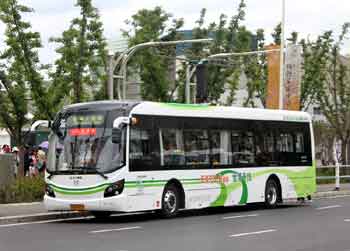 |
 |
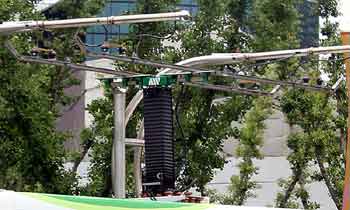 |
|
By the end of 2012 three bus routes were using capacitor buses. These are the 11, 26 and Chongming 1. In December 2012 the super-capacitor buses on route No.26 started being upgraded with a newer, lighter and more powerful ultra-capacitor power pack, and by March 2013
12 buses (half its fleet) had been upgraded.
According to the Chinese Academy of Engineering the new power pack is a high-performance nickel-carbon capacitor which combines the functions of both battery and capacitor. The higher capacity is cited as being a result of a double layer of honeycombed active
carbon and electrolyte that provides a larger surface area to generate electricity. (surely they meant store and not generate?) Included in the benefits that these power packs provide are: a wider range of operating temperatures (between -40°C and +70°C),
their still working well after 10,000 charge / discharge cycles, their being significantly lighter than earlier capacitor packs (down from 1.6 tons to 0.6 tons) and that the maximum range between recharges has increased from about 3 - 4km (a little under 2 - 2½ miles)
to over 10km (about 6¼ miles). This last benefit means that on short routes one charge might even cover an entire end to end journey.
Shanghai has 20,000 mostly diesel buses and as part of a desire to reduce urban air pollution is now looking at replacing between 1000 and 2000 of them with buses that use capacitors. Local officials see capacitor buses as being ideal for inner-city urban areas which do not require
high speeds, in residential housing areas and as shuttle bus feeders between residential areas and local metro (subway) stations, these being some of the locations where their not emitting any tailpipe air pollution is of the greatest benefit.
Even though it is only 10 minutes the time spent charging - especially if a bus is running late according to its scheduled timetable - does represent an Achilles heel (ie: nuisance / problem). The optimal solution would be to fit these buses with trolleypoles, as then they
could recharge from trolleybus wires whilst travelling - and would be able to easily perform a full day's work without delays. In addition, the overhead wiring would only be needed for relatively small segments of the route, ie: there would be no need to electrify the whole route.
In-motion recharging would also solve the traffic congestion problems caused by capacitor buses stopping to recharge - as described at the third link below
More information: 
http://www.shanghaidaily.com/Metro/public-services/Citys-supercapacitor-buses-improved/shdaily.shtml
http://www.chinadaily.com.cn/cndy/2011-11/09/content_14060802.htm
http://english.peopledaily.com.cn/90882/8163118.html
Other Chinese cities which are known to use fast charge electric buses include Chongqing and Ningbo.
As of December 2013 Chongqing had 31 of these vehicles, but were planning to have a large fleet of fast charge electric buses which can recharge in just 10 minutes. Alas, the information does not cite the energy storage technology but it is probably capacitors. 1000 such buses are planned,
plus an unspecified number for other nearby conurbations as well. Also in Chongqing are some natural gas - electric buses which have batteries that can be slowly charged in "plug-in" mode in the normal way and can also travel in "no charging" gas mode.
In August 2015 Ningbo introduced what will be the first of 1200 pure electric articulated buses which (they claim) only needs 10 second opportunity charges to supply enough power for 5km of travel. This is possible because it uses supercapacitors! The bus is manufactured by China South Locomotive
& Rolling Stock Corporation Limited (CSR).
With the Chinese government advocating increased use of electric buses as a way to reduce severe urban air pollution but experience having shown that batteries do not represent a viable long-term solution it is very probable that other cities will also look to capacitor buses as an alternative option.
Information sources: 
http://www.chinabuses.org/news/2013/0823/article_7553.html
http://www.chinabuses.org/news/2013/1104/article_7734.html
http://www.chinabuses.org/news/2015/0810/article_9060.html
Confusing Publicity Data.
A Chinese company involved in building (or promoting) the capacitor buses is using confusing data which suggests that they use 40% less energy than trolleybuses. Whilst they cite regenerative braking and the lower vehicle weight of the newer buses as being the reason, by not specifying
the exact vehicle types involved (ie: when built, whether rigid or articulated, etc.,) it becomes impossible for the non-critical reader to validate their comparison. It is assumed that they mean a 1950's era articulated trolleybus which lacks regenerative braking and was built with a
heavy metal chassis and body, plus thick (hence weighty) window glass. If so, then just about any present-era electric bus, whether trolley or capacitor, will be significantly more energy efficient. Even more so if (like all Chinese capacitor buses) it is of a shorter rigid (ie: not
articulated) type that features a specially designed lightweight body and internal fittings, plus uses regenerative braking! |
Sofia, Bulgaria
In May 2014 a Chinese capacitor bus was sent to Sofia, the Bulgarian capital city, for a 9 month evaluation period as a regular public transport vehicle on route No.11 from Stochna Gara to Gara Iskar. At the time the bus was claimed to be able to travel the entire 20km
(a little under 12½ miles) route on a single charge of just a few minutes duration. If this proves to be accurate it will indeed represent a bus industry game-changer for electric buses.
At the start of the trial it was mooted that if all went well then 600 such buses (spread over several years) would be introduced to service. At the time of this October 2015 update only the information in the links below is known.
Further reading: 
http://www.chariot-electricbus.com/pilot-projects/sofia/
http://www.china.org.cn/business/2014-05/17/content_32413382.htm
http://www.busandcoachbuyer.com/e-bus-makes-debut/ (2015 article reporting on a year of trial service).
The Gyrobus
Shanghai's trials with super-capacitors are reminiscent of a system trialled in the 1950's with what was known as a gyrobus.
The gyrobus concept was developed by Oerlikon (of Switzerland), with the intention of creating an alternative to battery-electric buses for quieter lower frequency routes where full overhead wire electrification could not be justified.
The buses were equipped with a large flywheel that spun at speeds of up to 3,000 rpm, gradually slowing as the stored energy was used to provide electricity for the buses' traction motor. Power for charging the flywheel comprised of three phase AC which
reached the buses via three roof-mounted booms which contacted charging points located as required / felt desirable (eg: bus stops en route, at termini, etc).
Fully charged a gyrobus could (typically) travel as far as 6km on a level route at speeds of up to 50 - 60km/h (depending on vehicle batch as top speeds varied from batch to batch) The installation in Yverdon (Switzerland) sometimes saw
vehicles needing to travel as far as 10km on one charge, although it is not known how well they performed (or otherwise!) towards the upper end of that distance. Charging a flywheel took between 30 seconds and 3 minutes, and in an effort
to reduce the time this took the supply voltage was increased from 380 volts to 500 volts. It can only be speculated whether such frequent delays would have been acceptable had the gyrobuses survived - in commercial service - into the modern
era. Especially on longer routes where several charging stops could have been required or on busy, heavily trafficked roads.
In all three locations used gyrobuses in full commercial service, these being Yverdon, Switzerland, Gent, Belgium and Léopoldsville in Zaïre. Whilst the technology worked reasonably well for various reasons none of these systems
lasted for more than seven years - at most. |
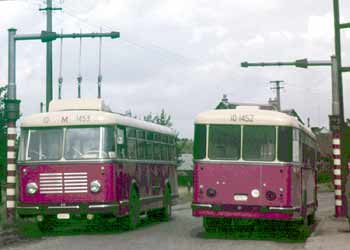 |
 |
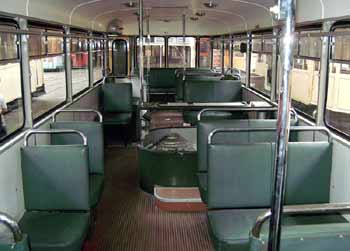 |
Gent, Belgium gyrobuses Nos 1453 and 1452 at an intermediate charging point. Although not seen here the photographer suggests
there were also two auxiliary contact arms that moved sideways from the gyrobus to make contact part way down the post.
Image dated to 24 August 1958 and is courtesy of Noel Reed. |
 |
Looking from the front towards the back inside the only extant gyrobus which is at the Flemish tramway, trolleybus and bus museum in Antwerp, Belgium.
It is assumed that when in normal service the equipment seen in the middle of the bus would be covered with a parcel shelf.
Image & license: Vitaly Volkov (user kneiphof) / Wikipedia encyclopædia.
CC-BY-2.0 http://commons.wikimedia.org/wiki/File:Gyrobus_G3-interior1.jpg |
Additional Gyrobus Information.
The gyrobuses used an asynchronous three-phase electric motor with condensers fitted on a common shaft. The motor was built on to a flywheel which (on the demonstrator) was 1.6m in diameter and weighed 1.6 tonnes.
This was housed in an enclosed hydrogen-filled air-cooled casing.
To obtain tractive power condensers would excite the flywheel's charging motor so that it become a generator, in this way transforming the energy stored in the flywheel back into electricity. Vehicle braking was electric and some
of the energy was recycled back into the flywheel, thereby extending its range.
The demonstrator was first displayed (and used) publically in summer 1950, and to promote the system this vehicle continued to be used for short periods of public service in a myriad of locations at least until 1954.
The first full commercial service began in autumn 1953, in Yverdon, Switzerland. However this was a route with limited traffic potential and although technically successful it was not commercially viable. Services ended in late autumn 1960,
and neither of the two vehicles (nor the demonstrator) survived..
The next system to open was in Léopoldsville in Zaïre (formerly the Belgian Congo and currently known as Kinshasa in the Democratic Republic Congo). Here there were 12 vehicles (although apparently some reports erroneously suggest 17), which
operated over four routes with recharging facilities being provided about every 2km. These were the largest of the gyrobuses, being 10.4m in length, weighing 10.9t, carrying up to 90 passengers and having a maximum speed of 60km/h (about 37mph).
However all did not go well, with there being major problems related to excessive "wear and tear". But it seems that a significant reason for this was because the bus drivers often took shortcuts across unmade roads, which after the frequent
heavy rains became nothing more that quagmires and marshes. Other problems included breaking gyro ball bearings and high humidity resulting in traction motor overload. The system's demise however came because of high energy consumption. The bus
operator deemed that 3.4kWh per km, per gyrobus, was unaffordable, so closure come in the summer of 1959 with the gyrobuses being dumped next to bus garage and left to rust.
The third location to use gyrobuses commercially was Gent, Belgium. Three gyrobuses started operation in late summer 1956 but instead of being the first of a proposed multi-route network they did not last very long, being withdrawn late autumn 1959.
It seems that the operator was blaming them for being unreliable "spending more time off the road than on" plus that their weight damaged road surfaces. They were also seen as being energy hungry, consuming 2.9kWh per km - compared to between
2.0kWh per km and 2.4kWh per km for much larger trams that carried several times the numbers of passengers. One of the three gyrobuses has been preserved as an exhibit at the Flemish tramway, trolleybus and bus museum in Antwerp, and it is sometimes
displayed as a curio (or even used to carry passengers!) at Belgian exhibitions, transport enthusiasts' bazaars, etc.
In 1985 it was used in the Belgian town of Ostend as part of the 100 year celebrations of the Belgian Vicinal light railway system. Photographs of this gyrobus at a charging station and at the museum (including several views inside it) can be found
at this page at the Wikipedia encyclopædia Commons:- http://commons.wikimedia.org/wiki/Category:Gyrobus_G3  |

Roadway Power / Gapbus
In addition to conductive charging another way to recharge the stored energy (batteries / capacitors) is via electromagnetic inductive charging.
Induction chargers typically use an induction coil to create an alternating electromagnetic field from within a charging base station, and a second induction coil in the portable device takes power from the electromagnetic
field and converts it back into electrical current to charge the battery. The major advantage of the inductive approach over conductive charging is that there is no possibility of electrocution as there are no exposed conductors.
Inductive charging is well known for low power domestic electrical items - such as toothbrushes and wet/dry electric shavers - where the reasons why it is favoured include that the battery contacts can be completely
sealed to prevent exposure to water.
However there are some drawbacks with inductive charging; these include that it has a low efficiency where much energy is lost in heat and that it is a relatively slow way to charge batteries - and whilst this is not an issue
for toothbrushes and shavers as they can be left on charge at all times§ - it is for buses and other transports which generally need to be in service as much as possible during their working day.
§ The cumulative effect of millions of householders leaving things switched on all the time poses significant environmental challenges, especially when the electricity is sourced from fossil fuel power stations.
The overall amount of extra energy that is consumed often requires extra power stations to be brought onstream, this being a cost that increases the price that the consumer is charged for their domestic electricity.
However showing much promise as potentially being more suitable for road vehicles is a variant of this theme known as resonance charging (or sometimes electro dynamic induction). This is claimed to be 80-90% efficient.
A very basic explanation of how this works is that the energy source features an oscillating magnetic field from which a ring coil on the receiver collects its energy. The closer the ring coil is to the source of the oscillating magnetic
field, the better the efficiency. For this reason buses which recharge whilst stationary have a kneeling function which lowers the charging units (power pick up coils) so that it is closer to the road-surface charging pad.
Buses which collect power using the various types of non-physical under-road induction have been dubbed 'gapbus' - because of the air gap between the road surface and the vehicle.
Stationary Vehicles |
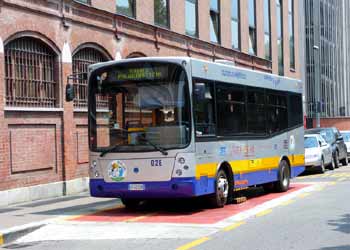 |
 |
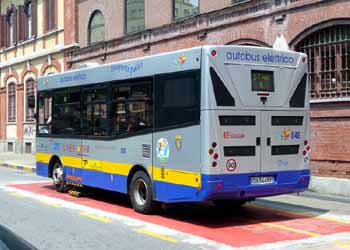 |
| An induction charged 7.5 metre (24½ ft) battery electric midi bus in Turin, Italy. Depending on various sources of information there are either 28 or 30 vehicles of this type operating in two Italian cities,
with there being 22 (or 23) in Turin (purchased 2002) and 8 in Genoa (purchased 2000 - although some sources suggest that the entire fleet dates from 2002). They use lead-acid batteries, seat 37 passengers and have a top speed
of a rather modest 70km/h (43.5mph). Full battery charges are carried out overnight, the induction charging adds an extra 10% - 15% per session of battery capacity, which is enough to keep the buses in service all day. |
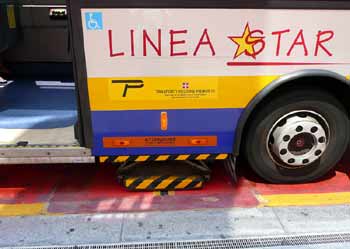 |
 |
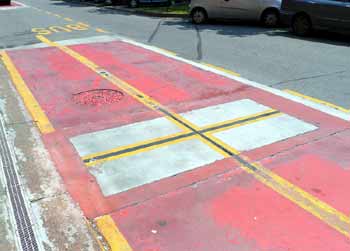 |
|
These trials use Conductix-Wampfler IPT® (Inductive Power Transfer) technology. This is an energy transfer system for electric vehicles that works by magnetic resonance coupling. The system consists of a primary coil in the road,
which is connected to the power grid, and a pickup coil fitted beneath the vehicle.
By 2012 induction charging in Turin and Genoa was considered mature enough for trials using larger buses to begin. So in autumn 2012 induction charged battery electric buses trial using standard sized 12 metre
buses began in the Dutch city of s’Hertogenbosch (Den Bosch). |
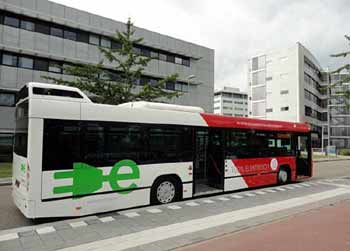 |
 |
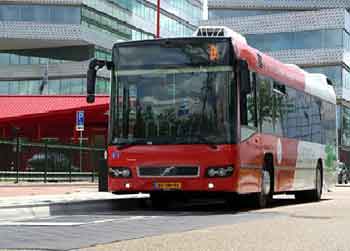 |
|
The plan is for the bus to travel 288km (179miles) per day without having to stop for prolonged periods or return to bus garage to recharge its batteries. The batteries will be fully charged overnight and topped-up by 10-15%
as necessary and as possible over the course of the day.
These trials are a collaboration of several partners, including the city of s’Hertogenbosch (Den Bosch): Bluekens Bus & Truck (building and supplying the bus), Conductix-Wampfler (supplying and erecting the inductive charging solution),
Heijmans (installing the charging points), Arriva (driver training and bus operation) and Enexis (connection of the charging system). More information: 
http://www.conductix.com/en/news/2012-10-01/first-large-electric-public-service-bus-wireless-inductive-charging-technology-tested-netherlands
Since December 2012 a battery electric bus which serves Ale municipality, just north of Gothenburg, Sweden, has been taking advantage of 'spare' time between journeys to top-up its batteries using induction. Unfortunately as part of an October 2015
page update it was found that the url to further information about this no longer works.
http://www.greengothenburg.se/new-technology-trialled-in-electric-buses 
In January 2014 a five year trial in Great Britain using induction charging commenced on the 15 mile (25km) bus route No. 7 which links Wolverton and Bletchley, these being two historic towns which nowadays form districts of the English conurbation
known as Milton Keynes. Whilst only seven diesel buses were needed to operate this service the extra time needed for charging the batteries when between journeys at the route termini means that eight battery electric buses are required*.
These buses will run for 17 hours a day, seven days a week. They have three battery packs per bus, one is located on the roof and the others are at the back, one each side. The batteries weigh 1.8 tonnes.
The timetables allow 13 minutes for charging, although it is expected that only 5-10 minutes will normally be needed. The extra time is to provide a margin in case of unscheduled traffic delays during the journeys. In addition to the induction power pads at
the termini there will be a third charging pad in Central Milton Keynes. Whilst primarily intended for gathering performance data about how the buses are faring en-route, this induction pad is capable of charging the batteries should the need arise. The
extra equipment for the induction system means that these buses have less ground clearance than is usual. Because of this and the large number of speed humps on the roads of Milton Keynes they had to be tested to ensure that they were suitable for the chosen route.
This technology trial is a collaboration of eight different businesses; more information: 
http://www.greencarcongress.com/2012/09/miltonkeynes-20120925.html
http://www.theengineer.co.uk/energy-and-environment/news/wirelessly-charged-all-electric-bus-route-is-first-for-uk/1014019.article
http://www.bbc.co.uk/news/technology-25621426
* Spring 2014 update:
Within months of the service commencing the media reported that the timetables have had to be recast to allow longer time (10 - 15 minutes) for charging the electric buses and that as a result of this to maintain the headway at busy times an extra
(diesel) bus has had to be drafted in. However the use of the diesel is not what was wanted and therefore there is now a desire for this extra bus to be replaced with what would be the ninth electric bus! Also worthy of note is that this issue has occurred before the electronic
next stop passenger information system has been brought into use and whilst the delay is partly because not all the back-end works have been completed there is also a concern over how much power it will consume and whether this will noticeably drain the batteries - and
require that even longer time is spent charging the batteries. |
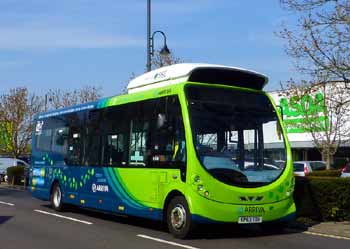 |
 |
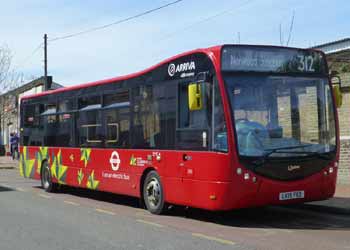 |
37 seater Arriva The Shires Wright StreetLite WF
Li-Ion battery electric midi-bus. |
 |
A London Optare MetroCity induction charged battery-electric midi bus on route No.312 outside Norwood Junction station. |
|
London is also trialling induction charged electric buses. In spring 2014 the Department of Transport’s Green Bus Fund funded four Optare MetroCity EV single deck buses which are used on route H98.
The induction charging pads are at a bus garage. Later in 2014 some more of these buses were introduced on route No.312. These were funded from TfL’s technology demonstration budget.
Also in London, in late autumn 2015 intermittent trials commenced using the first of three Alexander Dennis Enviro400H double-deck range-extended hybrid buses. These buses are being used on route No.69. As with other hybrid buses they travel as far as possible in battery
electric mode, the diesel engine is only used when / if the charge in the batteries becomes depleted. What is different however is that the batteries are also opportunity charged (via induction) whilst at both route termini. This is the first time that induction
charging technology has been used on a double deck bus. On the 9 miles (14 km) bus route the buses are expected to travel about 80% of the time in pure electric mode, with the onboard diesel powered generator being used the rest of the time.
The purpose of induction charging double-deck diesel hybrid buses is to increase the distance the vehicle can travel whilst powered solely by batteries. This trial will be part of the ZeEUS project
(Zero Emission Urban Bus System) as described elsewhere on this page. Buses which operate in this way are called extended range hybrids and Virtual Electric.
So far all trials with opportunity charging in London are on bus routes which have one or both ends at either an off-street bus station or a bus garage, this is being done so that the charging pads can be on TfL-owned property and there is less chance of other
vehicles blocking the charging pad. However if the technology becomes widely used it will require charging pads to be installed on the public highway. |
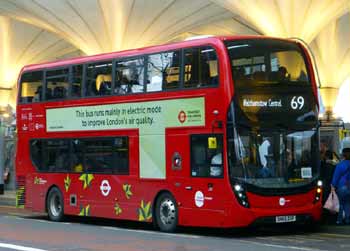 |
 |
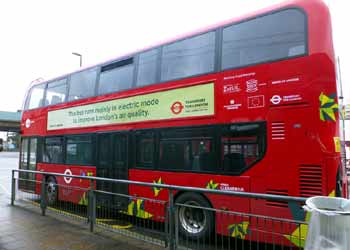 |
Extended range hybrid / virtual electric bus in London.

Two films showing a ZeEUS Project extended-range hybrid virtual electric bus have been placed on the 'youtube' film / video website and can be watched by clicking the links below.
- A short film which just shows the bus.
http://www.youtube.com/watch?v=9BW6TY4Jc0Q 

- A long film (nearly 20 minutes) which mostly comprises a ride inside one of these buses. Although the ride started downstairs there were so many passengers that after barely a few bus stops the film morphs into a "front seat / upper deck / forward view" ride through parts of east London, with added
commentary (road names, bus stop names, etc). In all the ride is from Canning Town station to Stratford station.
http://www.youtube.com/watch?v=rJ3wmsA5qeo 
In January 2016 two more of these buses were launched in the English city of Bristol where they will be used on route No.72 which runs from City Centre to the University of the West of England (UWE) Frenchay Campus, where they will use induction to top-up their batteries.
They will also use Geo-Fencing GPS technology to automatically run on pure electric mode in areas of low air quality, with the diesel engine only being used in areas of better air quality. These buses are being used in a partnership between First West of England, the Department for Transport,
Bristol City Council and the University of the West of England.
More information: 
http://www.firstgroup.com/about-us/news/first-west-england-launches-revolutionary-electric-buses
http://chargedevs.com/newswire/four-british-built-electric-buses-hit-the-streets-of-london/
http://thinkinghighways.com/londons-first-all-electric-bus-route-to-be-operated-by-arriva/
http://www.eurotransportmagazine.com/16648/news/industry-news/tfl-announce-two-further-electric-bus-routes-for-london/
(Note that the 51 single deck electric buses for routes 507 and 521 described at this link will NOT be opportunity charged. Also not using opportunity charging are the five BYD full-electric double deck buses which in early May 2016 started working on London bus route 98).
Until now it had been thought that for a pure electric bus to have sufficient batteries to allow for reasonable distances to be travelled on a daily basis it would need batteries which weigh so much that to avoid exceeding the legal weight limit for twin axle buses the bus
would either need a third axle or a lower passenger capacity. However it seems that a 'wildcard' third option is to be adopted. So desperate are certain powerful people for these buses to be found viable that the Department for Transport is going to give them a 1.5 tonne weight
derogation and therefore they will be permitted to weight up to 19.5 tonnes. Without this they could not carry standing passengers, which would be unacceptable in London.
In addition, to make life easier for other bus operators to use heavier buses without also needing a derogation the legal weight limit for all twin axle buses is to be raised. The reason why road vehicles are subject to weight limits is that heavier vehicles cause greater wear on road
surfaces and subterranean formations. So, it could be that local governments will find themselves needing to spend extra money, more frequently, repairing roads and bridges - this has already happened on some roads, as a result of permitting heavier goods vehicles on our roads.
PRIMOVE
In autumn 2008 a major transport vehicle manufacturer announced proposals for an induction system which would be installed under the road along (much of) the transports' route, with the vehicles drawing power as they travel over it; and also storing their own regenerated braking energy
to lower the overall demand on the power supply system when the vehicle is accelerating from rest and permit operation at locations where there is no power supply. At first this was conceived with trams in mind however it was soon realised that the technology should be suitable for road
vehicles as well - including electric buses.
The company is Bombardier, the technology is known as PRIMOVE. The trails with trams also involved the Mitrac capacitor energy storage system which was created for regenerative braking but also allows trams to travel short distances without an external power supply. For trials
with buses Bombardier have developped an entirely new high-power nickel manganese cobalt (NMC) lithium-ion battery which has been optimised to maximise performance and includes an advanced thermal conditioning unit which maintains its ideal temperature, enables rapid charging and recovery
of braking energy recovery plus has an expected life span of up to ten years.
For trams the buried Primove inductive loops will typically be located between the tracks / above the sleepers at tram stops and on uphill gradients. For street trackage they would need to be covered by a 40mm layer of non-conductive material such as resin, asphalt base or non-reinforced
concrete. Away from the inductive loops the tram would be powered by the Mitrac stored energy system. For rubber tyred road transports the buried Primove inductive loops will be placed at bus stops and dedicated charging locations.
The charging pads are eight metres in length and fed by an inverter which transforms 750v DC into 200 kHz AC. They are only 'live' when the transport is over them. The transmission efficiencies of 90% - 95% are claimed to be only 2% less than those achieved with physical contact systems.
Several locations have been involved in research, development and trails, these are summarised below. The best place for more information is the Primove website - the link below leads to a page on the Primove website from where it is possible to download
fact sheets with in-depth specifications for the entire project and the various specific urban projects. Note that these are in pdf (portable document) format and depending on computer operating system may require the installation of the free Adobe Acrobat (or equivalent) pdf reader.
As the pdf format data sheets suggest, development works with buses have involved partnerships with various bus manufacturers.
http://primove.bombardier.com/  . .
More about wireless charging can be read here: 
http://www.wired.com/2013/03/wireless-charging-bus-germany/
- After initial development works had started in 2003, the first test track in a non-public location was created in 2009 at a Bombardier factory in Bautzen, Germany. This was 1km in length.

- The first pilot demonstration trials within the public domain involved a specially modified Bombardier low-floor tram which used an 800m section of tramway which is only used in public service during events at the exhibition centre in Augsburg, Germany. This proved the system’s reliability under
all environmental conditions and full compliance with all applicable codes and standards for electromagnetic compatibility. A May 2012 press release discussed the success of these trials which began in 2010 and also revealed that trails had been underway with an electric road vehicle and that a
new Centre of Excellence for electric mobility technology had been built in Mannheim.

- In October 2010 Bombardier joined the Flanders’ DRIVE project in Lommel (Belgium) in which a consortium of industrial companies and R&D specialists came together to research the potential of inductive charging for electric road vehicles. The 125 metre test track has been used by both a
bus and a Volvo C30 car. The bus was involved in both dynamic and static trials and the car in solely static trials.

- The Mannheim Centre of Excellence for Primove technology actually opened in September 2011. Then in November 2012 the first Primove equipped e-bus was homologated for operation on public roads. Further developments in Mannheim have included real-world trials on bus route No.63 which
is 9km in length, serves 21 bus stops and has an approximate 33 minute end-to-end journey time. Included in this project is the installation of eight inductive charging pads - one at each route terminus (for charges of up to 7 minutes), five at intermediate bus stops (for charges of up to 2 minutes)
and charging pad at the bus garage (for charges of up to 15 minutes). Two buses were involved in this 12 month project during which time they became the first Primove equipped induction buses to carry fare-paying passengers.

- Trials in Mannheim also involved a Primove equipped electric van which was used as a service vehicle. This e-van was only charged at the bus garage, a process which usually took about three hours.

- May 2013 saw the commencement of a further round of trials, this time in the German city of Braunschweig. This is known as Project EMIL. The buses travel in public service on route M19 which comprises a 12km loop service around the city that has a typical journey duration of 37 minutes. The first of
the buses arrived late 2013. This was the 12 metre vehicle which has a 60 kWh battery. Passenger services using this bus were launched on 27th March 2014. On 22nd December 2014 four 18 metre Solaris Urbino 18 articulated buses (which have 90 kWh batteries) were
introduced, replacing the diesel buses on this service. All five battery electric buses receive a full overnight charge plus approximately 11 minute top-up charges on a 200kW inductive charging pad whilst between journeys at the route terminus (the main railway station). Experience has shown that
the battery on the 12m bus is about half empty after one journey around the loop. The articulated buses also receive 30 second boost charges at two intermediate charging pads which are about 4km into the route and then 6km along the route. This therefore is true opportunity charging - as only
the buses which need the extra charge use the intermediate boost charging pads. An unexpected surprise is the need for a blowing unit to keep the charging plate free of leaves.

- In August 2015 a Primove trial commenced in the German city of Berlin. This is the first time that a wirelessly charged electric bus had been used in a capital city. The four 12m Solaris buses with Vossloh Kiepe electric drive and higher rated 90 kWh batteries are used on inner-city route No.204 between
Südkreuz and Zoologischer Garten (Hertzallee). At night their batteries are fully charged using the four direct (wired) charging stations which have also been built at the bus garage. At the same time the air-conditioning (or heating) is run so that the bus will be fully ready for public service
in the mornings. The bus garage also has a mobile charging station. During the day the buses receive 4-7 minute top-up charges from induction pads at the route termini. There are no intermediate charging pads. Someone who lives in Berlin has suggested that there have been issues with parked vehicles blocking
the induction charging pads and this has (at times) 'made life difficult'.

- In October 2015 two Primove equipped 9.7 metre Van Hool A308-EV battery electric midi-buses which have 36kWh batteries were introduced on a brand new bus route in the Belgian city of Bruges. This 5.6km service travels along historic narrow streets and through the middle of the medieval old town, which
is a designated Unesco world heritage site. A fully charged battery enables the e-bus to travel for 45 minutes without recharging. After serving the route a few times back and forth, the e-buses are recharged at the 200 kW PRIMOVE charging facility which is at the bus garage. Two e-buses are used on weekdays
and one on Saturdays.
|
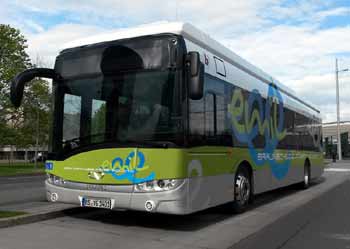 |
 |
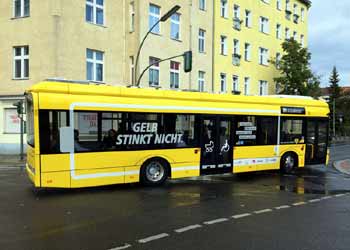 |
Battery electric Solaris Urbino 12 bus No.1401 operated by Braunschweiger Verkehrs-AG as part of Project Emil. The white patch of road is where its batteries are opportunity charged by means of electromagnetic induction.
Image & license: Lord Alpha / Wikipedia encyclopædia. CC-BY-SA-3.0
http://commons.wikimedia.org/wiki/File:BSVAG_Solaris
_Urbino_12_electric_%22EMIL%22_Hauptbahnhof.jpg |
 |
Battery electric Solaris Urbino 12 bus No.204 operated by BVG near the Torgauer Straße bus stop in Schöneberg, Berlin.
Image & license: A.fiedler / Wikipedia encyclopædia. CC-BY-SA-3.0
http://commons.wikimedia.org/wiki/File:BVG-204-Solaris
-Urbino-12-electric-Torgauer-Str-3.jpg |
Montreal, Canada
A Primove technology trial in an extreme cold weather climate has also been suggested for a private test track on Île-Sainte-Hélène, the home of Expo 67, Montréal, Canada. The first two links below reference winter 2013 / 2014 however as the third but no longer working
link suggested, this did not happen. This is still believed to be planned, as a first stage towards the possible full commercial use of inductive powered buses in Montréal. Included in the information which it is needed to learn during the trials is how the technology copes with some of the harshest
wintry conditions that can be expected in an inhabited area. This data is important to help plan the number of inductive charging points which would be required for a fully commercial service to be viable, bearing in mind the high amounts of power needed for winter heating and summer cooling - not just of
the interior of the bus but also the batteries, as these too work best at within a certain temperature range.
These two links reference the planned winter trial: 
http://www.cbc.ca/news/technology/bombardier-to-test-electric-buses-that-charge-wirelessly-1.1385344
http://business.financialpost.com/news/transportation/bombardier-electric-technology-to-be-tested-on-buses-in-montreal-germany
This two-page Montreal Gazette newspaper article explained why the trials did not commence within the originally mooted time frame, unfortunately the article is no longer online and the link is dead.
http://www.montrealgazette.com/business/Bombardier+electric+takes+road+Germany/9669923/story.html
Other Induction
Also involved in opportunity charging via induction of stationary battery-electric buses is the US-based Wave inc. WAVE is an acronym for Wireless Advanced Vehicle Electrification. The technology was developed at Utah State University although it
is now being marketed by WAVE inc., which is a spin-out company. WAVE mostly uses 50kw charging pads, although their first electric bus, which operates shuttle services within the Utah State University campus, uses a 25w charging pad. This
vehicle is nicknamed the Aggie Bus.
Their website lists seven sets of projects which use WAVE induction charging, enabling battery buses to stay on the road all day. Their projects include over a dozen Chinese BYD battery electric buses, electric buses sourced from within the USA and the replacement of a diesel vintage trolley
styled bus with one that uses battery electric propulsion.
This link leads to the WAVE website: 
http://www.waveipt.com/
Whilst it is hoped to be being fair to all organisations which are trialing these new technologies with public transport vehicles and at least mention them, there always remains the possibility of lower profile developments remaining unknown.
Moving Vehicles
Much more challenging than with stationary vehicles is the ability to supply energy using induction to a vehicle which is in free motion on a road and to ensure that it works even with a constantly changing gap between the vehicle and the road surface.
The concept is not new, as in the early 1990's proof-of-concept trials were carried out with a 35 seat Roadway Powered Electric Vehicle (RPEV) at the University of California Richmond Field Station. The trials saw the burying of power
conductors under a 700ft (about 213m) test track and an operational RPEV which featured a needle dial so that as the vehicle travelled along the road the driver could see the strength of the charging current being received
and accurately locate the vehicle above the under-road power supply.
The RPEV system was shown on television as being able to draw enough power from below the road surface that it could also roam away from the power source, so that perhaps a main road serving many bus routes would be electrified
but they would be able to make short scheduled detours in battery electric mode. However despite the technology still being in need of refining before it would be ready for full commercial exploitation once these trains had been completed
the project became stalled. Perhaps this was because between 1992 and 2000 the USA had a President who was a member of the oil industry - if so then the lack of further development is not at all surprising. A report on these trials
used to be available online at this link, which no longer leads anywhere.
http://ntlsearch.bts.gov/tris/record/tris/00773755.html. 
But whilst the American leadership did everything it could to roll back further development in electric transport technologies (with increased use of fossil fuels being the primary aim) further development work in Korea resulted (in March 2010)
in a more advanced variant of the RPEV being launched in Seoul, Korea. Known as the On-Line Electric Vehicle (OLEV) the technology is being tested on a 2.2km route at Seoul zoo which is served by a 'road train' that had
previously been criticised for its diesel exhaust fumes.
Researchers at KAIST (Korea Advanced Institute of Science and Technology) succeeded in refining the technology so that it offers power transmission pick-up capacity of 62kw, at up to 74% efficiency, over an air gap between the road
surface and the bottom of the vehicle of around 12cm - 13cm (about 5"). |
|
In Seoul zoo the OLEV train travels along 2.2km route which is equipped with four sections of under road power supply equipment.
Sections 1, 2, and 3 are each 122.5 metres in length, whilst Section 4 is just 5 metres in length.
This makes for a total length of subterranean power supply cables of 372.5 metres, which is just 16% of the 2,200 metre route.
The OLEV trail 'train' at Seoul Zoo which is formed
of one engine and three passenger carriages. |
 |
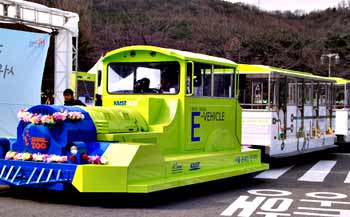
Image: Kaist publicity material at the 'kaist.ac.kr' link below. |
|
If the technology proves viable it will be installed along the bus lanes in many city streets, as since buses account for 30% of all city traffic so electrifying them is being seen as providing a significant impact in reducing urban
air pollution. It is estimated that only about 20% of a route's entire length would need electrifying, although if evidence from the OLEV is correct then this would include bus termini so that buses could be recharging their batteries whilst
stationary between journeys.
A different press release talks about an experimental plan which would see power strips between 20cm (about 8") to 90 cm (about 35") wide and perhaps several hundred metres long being built into the road surface along
about 10% of the entire road system of an urban area, so that road vehicles will only need small batteries which store enough energy for about 50 miles (about 80km) of travel. These small batteries would be about a fifth (20%) of the
size of the batteries used in existing battery vehicles.
The next stage of the development of OLEV technology is for a public bus service to use it. This is underway in the Korean city of Gumi. The news.kahn.co.kr article linked below suggests that the trials will involve a bus (similar to those used
on the Namsan area seen above) travelling on a 12km (about 7½mile) route making about 10 journeys daily. Although there is additional information the online translation is not robust enough to understand exactly what
is being said.
However information from other sources (printed paper and online) suggests that the Gumi trial involves two battery-electric buses and that only 10% - 15% of the route followed by the buses will need equipping with inductive power supply for them to
have enough power in their batteries to ply the entire distance. The online German language newspaper (Bild.de - link below) says that the bus route used by the trial buses is 24km in length; this is somewhat confusing although perhaps the higher
figure refers to the distance travelled on return journeys.
The under-road power strips are 5 metres in length. They can be laid end-to-end to create longer sections of roadway power, with only the section under the bus being energised at a time. The air gap between the road surface and power collector on the
bus is approximately 17cm (a little under 7").. Transfer efficiency of the 20 kHz / 100 kW power emitted from the cables is rated at maximum 85% and one source of information has stated a concern about the remaining (unused) 15% of the
energy causing stray current leakage which would breach European Union Electromagnetic Compatibility regulations, which leaves a question mark over this system's suitability for use in Europe.
Future plans are that in 2015 there will be ten more battery-electric buses (ie: 12 in total). Another online source suggests that pilot trials are being planned in four other Korean regions.
Further information: 
http://olev.kaist.ac.kr/en/
http://www.koreatimes.co.kr/www/news/nation/2010/03/117_62152.html
http://news.khan.co.kr/kh_news/khan_art_view.html?artid=201301102209555&code=940100
http://www.wired.com/2013/08/induction-charged-buses/
http://kojects.com/2013/08/13/wireless-charging-electric-bus-in-gumi/
http://smfir.co.kr/ (Kaist Wireless Power Transfer Research Center)
http://www.bild.de/auto/auto-news/alternativer-antrieb/strasse-elektroautos-kabellos-laden-31708204.bild.html
http://chargedevs.com/features/olev-technologies-dynamic-wireless-inductive-system-charges-vehicles-while-in-motion/
http://www.eurekalert.org/pub_releases/2013-08/tkai-kwo080513.php
 |
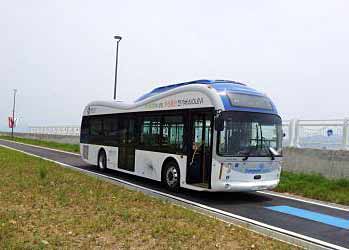 |
 |
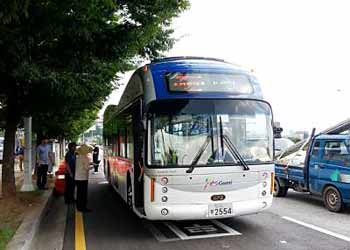 |
KAIST publicity images for the Gumi demonstration project which involves buses collecting power from the road surface whilst they are travelling along specially equipped sections of road.
US OLEV Trials Falter
In 2011 it was announced that the Texan city of McAllen would be using 3 OLEV buses on a 10mile (16km) route. This would be in conjunction with the OLEV Technology Corporation which is based in Massachusetts and is a
venture company in which KAIST has a 30% share. The corporation has the sole license to commercialise OLEV technology in the USA. However due to financial reasons this scheme was cancelled in October 2012. This link explains more: 
http://www.themonitor.com/news/local/article_ebf8547a-208e-11e2-97cd-001a4bcf6878.html
However, instead in January 2016 McAllen starting using two electric buses equipped with WAVE technology (which is for buses that are staionary), as described under "Other Induction" above.
Read more: 
http://www.masstransitmag.com/press_release/12162805/wave-technology-install-completed-for-city-of-mcallen-electric-buses
Project Malaga, Spain
Launched in September 2013 the Proyecto Málaga will see a tri-mode battery bus being trialled on the 10km route 16 in Malaga, Spain.
The bus will be fully charged at night in the bus garage (using conventional methods) with partial charges during the day using wire-free induction - both whilst stationary and whilst in motion.
Trials were expected to begin in December 2014, but it remains unknown whether this did actually come to pass.
More information: 
http://www.energynews.es/english/malaga-to-implement-a-dynamic-induction-system-for-recharging-electric-buses/
http://www.endesa.com/en/saladeprensa/noticias/wireless-en-route-charging-electric-buses
Volvo Moving Vehicle Induction
In addition to creating a new way to opportunity charge buses by means of an overhead pantograph, Volvo are reported to be looking at using under-road induction charging of moving vehicles.
More Information: 
http://chargedevs.com/newswire/volvo-may-test-dynamic-wireless-charging-on-swedish-city-bus-line/
Physical Contact Roadway Power
Stream
In 2000 an Italian "roadway power" technology which was specially designed for buses was tested with several electric buses in the Italian city of Trieste. Unfortunately however the trials coincided with a change of local
government - and whilst it seems that the outgoing politicians were keen to see the system expanded to more routes the new politicians were not.
Perhaps at least in part this was because the trials were on one of the cities' busiest bus routes and there was some disruption, especially when it was being installed. |
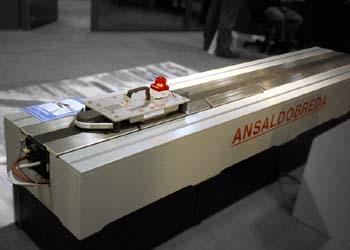 |
 |
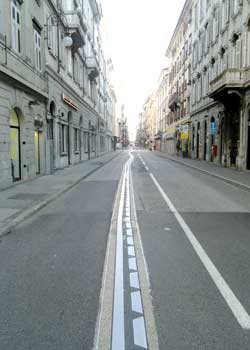 |
| A demonstration section of the experimental 'Stream' road surface power trackage and collection skate as seen at the 1999 UITP exhibition in Toronto, Canada. On this display version the red
light on the skate illuminates to demonstrate that power (low voltage in this instance) is being received. |
 |
Stream road surface power trackage in Trieste.
Image & license: Luca Fascia / Wikipedia encyclopædia. CC BY-SA 3.0
http://commons.wikimedia.org/wiki/File:STREAM_TRIESTE.jpg. |
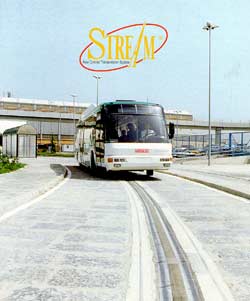 |
 |
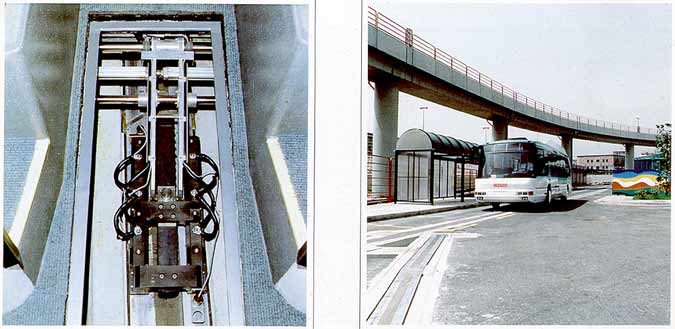
These two images include a view of the power collection skate as seen from inside the bus. When the bus is in motion the skate tracks the power trackage by wandering from side to side under the bus.
Images above & left: the vehicle manufacturers' publicity material. |
The technology was based on twin metal conductors located on the road surface. To ensure safety and avoid the possibility of electric shock the conductor that carried the live power was split into short sections that
would only be live when the bus was actually over them. This system only ever existed in experimental form, however one specific technical problem which the Trieste trials identified was that the metal (of the power conductor)
on the road surface could be slippery, especially when wet.
Since these trails marketing of this system ceased and in 2009 it was replaced by a different technology called Tramwave® which (so far) has only been tested with trams, although it is said to be
suitable for buses as well.
In 2012 the disused experimental Stream power supply system was removed from the streets of Trieste.
In summer 2015 a major transport vehicle manufacturer announced proposals for new power supply system, variants of which would be suitable for both buses and trams.
SRS is marketed as being a further development of Alstom's APS technology which several tram systems use to collect electrical power from twin power conductors located on the ground and midway between the tracks. However, whilst the implementation is very different
it also has many similarities with the opportunity charging systems seen elsewhere on this page.
SRS works with the Citadis Ecopack energy storage system which uses on-vehicle capacitors that are recharged at bus or tram stops during a 20 second stop dwell time. Power transmission is via pick-up shoes (one for trams, two for buses) which lower on to conductor
rail(s) that - from how it looks in the animation video - are slightly proud of the ground surface.
Radio communications between vehicle and power supply system ensure that all is well and that the power rail(s) is / are only energised when the vehicle is actually 'present and correct'.
Alstom promotional material says that SRS is suitable for trams and buses, regardless of manufacturer. Of course ensuring that no other vehicles are blocking the bus stop is an essential feature.
In 2017 SRS will be installed on two new tramlines in the French city of Nice.




 A film showing these buses at this location outside the railway station which includes several scenes
(taken from different angles) of the bus driver physically plugging the power cable into the bus (and unpluging too) can be seen on YouTube at this link:
A film showing these buses at this location outside the railway station which includes several scenes
(taken from different angles) of the bus driver physically plugging the power cable into the bus (and unpluging too) can be seen on YouTube at this link: 






























































